Music is the universal language
“Glory to God in the highest heaven, and on earth peace to those on whom his favor rests.” - Luke 2:14
Premier Guitar
PRS Guitars Announces New SE Models Plus a New Combo Amp Ahead of 2026 Updates
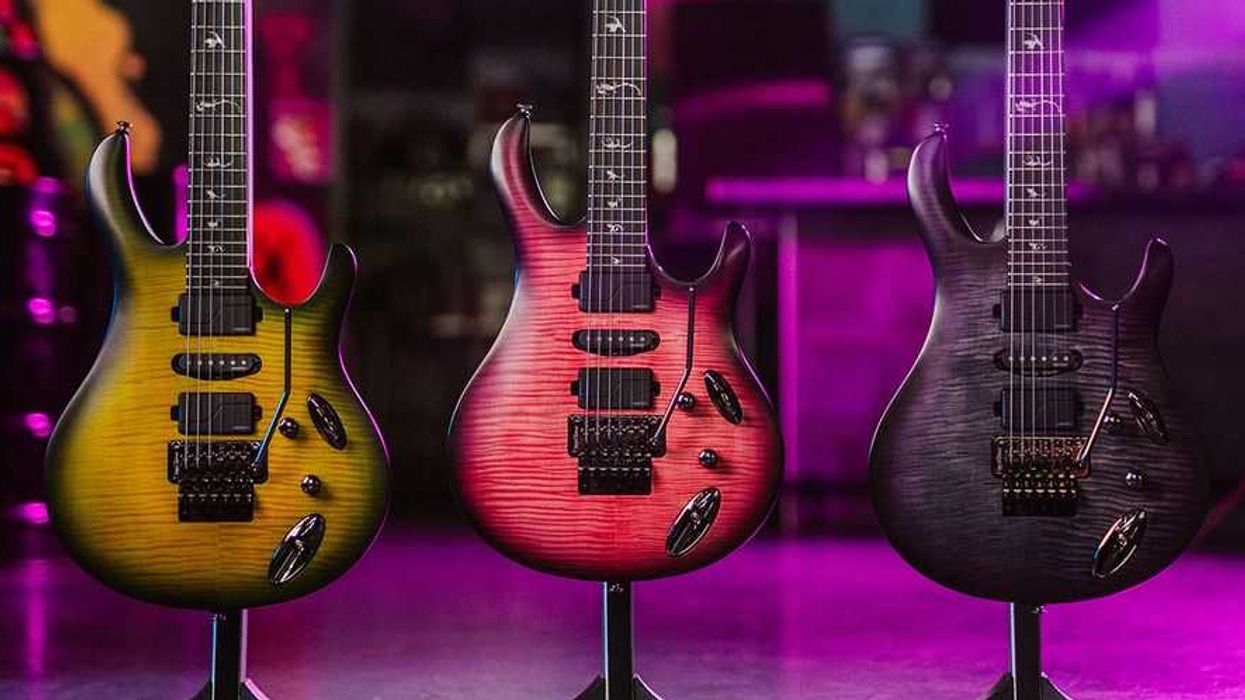
PRS Guitars today announced several new SE Series models and the David Grissom signature DGT 15 amplifier as a combo. Along with the debut of the SE version of Herman Li’s signature model Chleo, the fresh models include the SE DGT Standard and the SE CE 24 Standard Satin Stoptail. 2026 also brings a construction update to the SE Hollowbody Standard, SE Hollowbody Standard Piezo, and SE Hollowbody II Piezo. Rounding out the launch, the DGT 15 amp brings the acclaimed tone and versatility of the DGT 15 head into a convenient, combo format.
SE CHLEO
The SE Chleo is the result of an intimate collaboration between PRS Guitars and award-winning guitar player Herman Li. Best known for his work as one of the lead guitar players in the power metal band DragonForce, Li is a demanding guitarist known for his fast and precise playing style. Based on the exclusive 2025 PRS Chleo Limited Edition, this SE signature model is a unique guitar in the PRS lineup designed with the modern metal guitarist in mind. The SE Chleo boasts the same Fishman Fluence Signature Series Omniforce Herman Li pickups as the Limited Edition that preceded it. With three distinct voices and a versatile switching system, the guitar offers up to 13 unique tone combinations.
“With the PRS SE Chleo, we set out to create the best affordable guitar that delivers a unique combination of effortless playability, outstanding craftsmanship, and versatile tonal range. It combines modern innovations with classic style, giving players the tools they need to create everything from classic tones to cutting edge new sounds. The SE Chleo proves that a world-class instrument doesn’t have to break the bank—it’s a guitar that brings high-end performance within reach for everyone,” said Herman Li.
In addition to the Charcoal Purple Burst and Orchid Dusk that the Limited Edition models were offered in, the SE Chleo introduces a third color, Mantis Burst.
SE DGT STANDARD
The SE DGT Standard brings David Grissom’s signature model to a stripped-down, all-mahogany platform, delivering organic tone, rich resonance, and bold midrange presence, all at a price that comes in slightly below the SE DGT. The SE DGT Standard adds warmth and growl to the model’s signature clarity and articulation. Like the SE DGT, the SE DGT Standard offers a versatile control layout with individual volume controls for each pickup, a master tone control with push/pull coil tap, and a PRS tremolo.
SE CE 24 STANDARD SATIN STOPTAIL
The SE CE 24 Standard Satin is now offered in a stoptail option. The SE CE 24 Standard Satin Stoptail joins its tremolo counterpart as the lowest-priced guitar across all PRS models, at just $499 USD. This new version brings the snap and response of a bolt-on guitar into an all-mahogany body for a warm, focused tone, now paired with the rock-solid stability of a stoptail bridge. Loaded with 85/15 “S” pickups and a push/pull tone control for coil tapping, the SE CE 24 Standard Stoptail packs impressive versatility, whether players are chasing classic humbucking growl or snappy single-coil sparkle.
UPDATED MODELS
Through close work with Cortek, PRS has updated the construction process of the PRS SE Hollowbody models. The center section is cut from solid mahogany, as opposed to bending the sides, so the body shape is now “fully PRS.” The SE Hollowbody II Piezo’s top and back are still made with 5-ply laminated maple for strength and rigidity. The PRS SE Hollowbody Standard models keep their all-mahogany build, while also benefitting from this construction update.
This construction method also allows more color options, so Vintage Sunburst has been added into the lineup on the PRS SE Hollowbody II Piezo. With the SE Hollowbody II Piezo, players can plug into the “Mix/Piezo” jack and use the individual volume controls to blend the 58/15 LT “S” pickups with the piezo’s acoustic tones. Alternatively, players can plug into the jacks separately, so the guitar can run magnetic pickups into an amp and run the piezo through an acoustic amp or DI into the soundboard.
DGT 15 COMBO AMP
Designed in close collaboration with guitarist David Grissom, this 15-watt, single-channel amp delivers vintage-inspired tone and gig-ready portability—all in one compact package. The built-in master volume and 3-position bright switch allow for detailed tone shaping at any volume level. Additional features include a 3-band tone stack (treble, middle, bass), boost, tube-driven reverb, top cut, presence, and tremolo. Like on the head version, it is not just the controls, but the combination of the controls and control parameters that bring out this amp’s functional versatility. For example, the bright switch can be set to on, off, or on except when the boost is engaged, so players can intricately manipulate the amp’s high-end. The Master Volume can be set to be on, off, or on only with the Boost. The included 3-button footswitch allows control of the boost, reverb and tremolo.
"I’m very excited the DGT 15 is now available as a combo amp! With a tweak to the circuit and a lot of work on the cabinet design, the combo has a tight, robust low end and a slightly more open tone than the head/cab version, all in a lightweight 1x12 combo format,” said David Grissom.
PRS Guitars continues its schedule of launching new products each month in 2025. Stay tuned to see new gear and 40th Anniversary limited-edition guitars throughout the year. For all of the latest news, click www.prsguitars.com/40 and follow @prsguitars on Instagram, Tik Tok, Facebook, X, and YouTube.
Stompboxtober 2025: Mr. Black Pedals

Stompboxtober rolls on! Enter today for your chance to WIN the DoubleTracker Stereo from Mr. Black — true stereo double‑tracking that brings lush depth, detune magic, and studio-grade dimension to your sound. Don’t forget to come back tomorrow for the next pedal giveaway!
Stompboxtober 2025 - Win Pedals All Month Long!
Mr. Black DoubleTracker Stereo
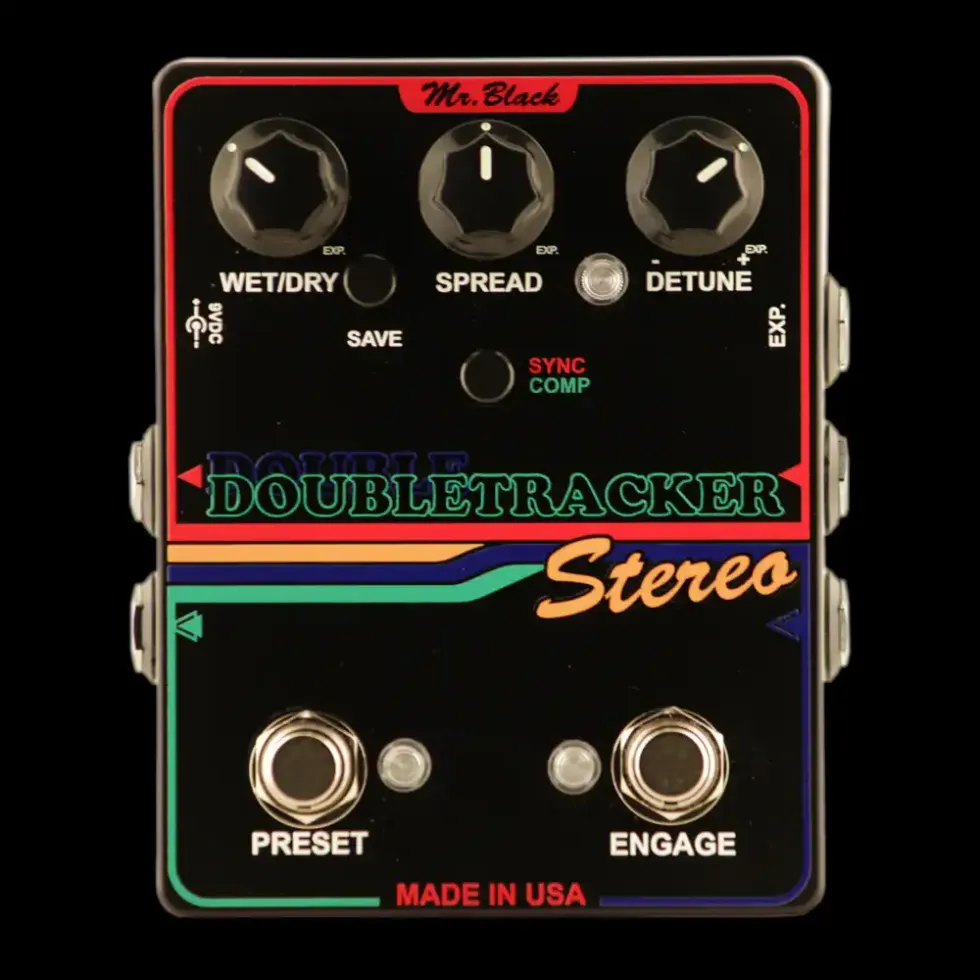
The DoubleTracker Stereo delivers lush, organic stereo doubling with adjustable delay, pitch, and spread. Featuring dual isolated paths, intuitive controls, and unique SYNC/COMP modes, it adds depth and dimension to any instrument—perfect for guitar, bass, keys, vocals, and studio work. It’s not chorus. It’s Double Tracking. $279.95 Street
Mod Garage DIY Guitar Makeover: First Steps and Needle Files
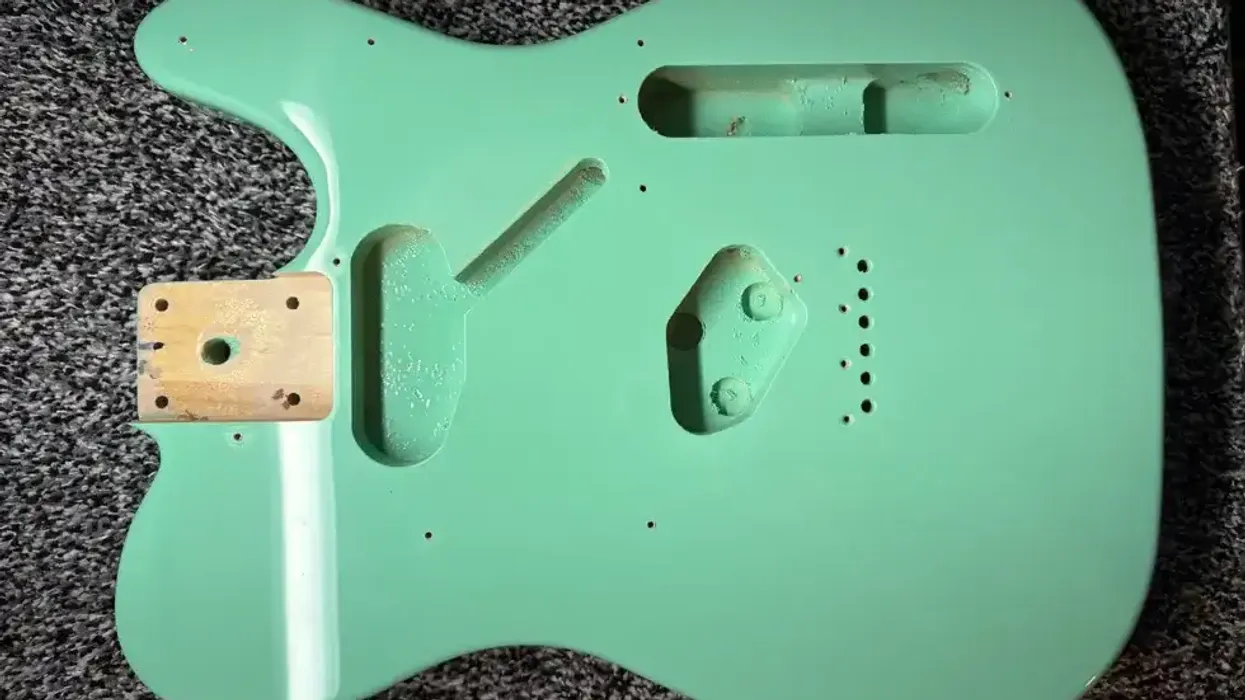
Hello, and welcome back to another installment of Mod Garage. My homework for this month’s column was to completely disassemble last month’s Harley Benton guitar, and as expected, there were some surprises under the hood.
The first surprise hit me while taking off the factory-installed strings. While doing so, all six string ferrules fell out of the body onto the floor. While it’s not a rare scenario that the ferrules on a Telecaster can be pulled out easily, this was special. It’s not a big problem, because with the strings installed, the string tension will hold them in place, but who wants to search for the string ferrules on the floor every time you need to change the strings—especially on a dark stage floor in the middle of a gig? This is not custom-shop grade, so it was the first issue on my list.
After measuring the diameter of the drilled holes in the body and the ferrules, it was clear why they fell out: The holes are a lot larger than the diameter of the ferrules. It was clear that I can’t glue them in for a better fit, nor use tape to compensate. There were only two real solutions: close the holes in the body with wooden dowels and drill them again, or use different ferrules matching the diameter of the holes in the body. The stock bullet-shaped ferrules are very cheaply made, so I decided it wasn’t worth the work to save them. I ordered a new set of ferrules with a larger diameter than the holes in the body (making an existing hole bigger is much easier and less work than filling it and starting from zero). I picked a standard set of vintage protruding ferrules—the first $12 on our bill.
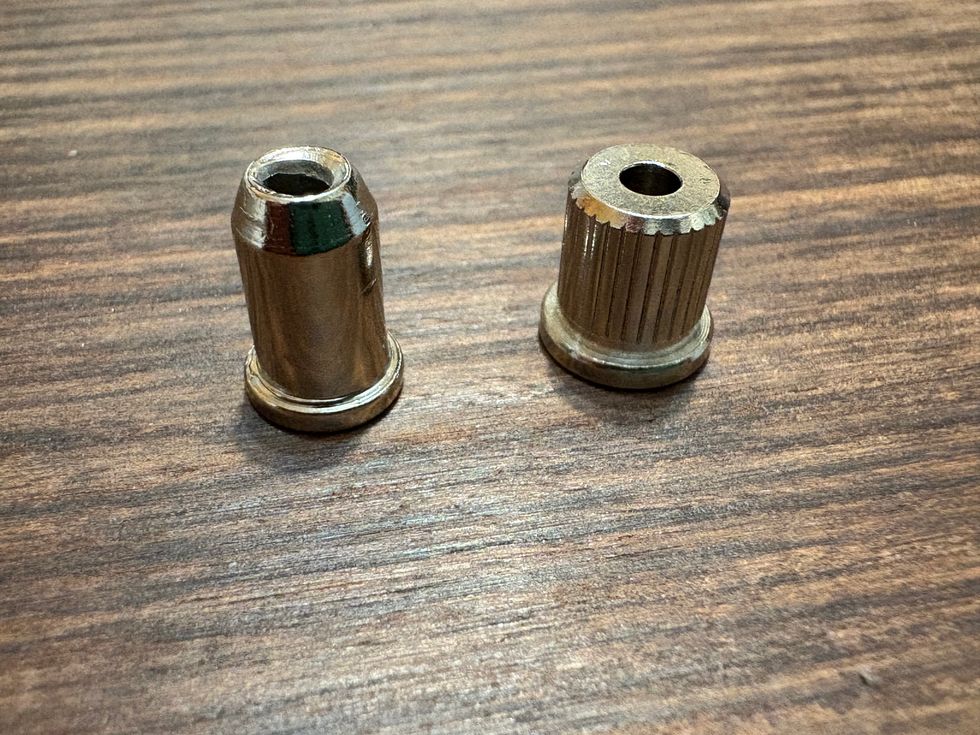
This wasn’t the best start, but it is what it is! After taking the guitar apart completely, I made a game plan. Visually, I want to keep it mostly vintage looking, but with a modern twist to get the best of both worlds. I decided to age the hardware only slightly to give it a used and worn look, but with no rust or artificial damages. Same with the body and neck—while the neck already has a satin-matte look, the body is very shiny and glossy. I’ll break the shine, giving it a matte and used look but without cracks or damage. This will lend the color a much more pleasing vintage appearance, and it’ll feel much better compared to the high-gloss finish. The complete guitar weighs only 7.2 lbs (3.3kg), which is really lightweight for a Telecaster. I really like light electric guitars, so I’ll attempt to shave off even more weight during this process.
Let’s start with analyzing the body of our guitar to see what we have. It’s easy to see that saving time and cutting costs were principal directives—which is understandable given the price of the guitar. Let’s love it for what it is rather than hating it for what it isn’t. The rough-hewn body is very lightweight and made out of basswood, which is not a traditional “tonewood” for electric guitars. It’s the first choice for carving and woodturning work of all kinds because it’s relatively soft; easy to work with, but solid. From the neck pocket’s vantage point, we can tell that the body isn’t made of one or two pieces of wood, but of many, many more. In the neck pocket alone, I can count four pieces, and I wouldn’t be surprised if the body is made out of 15 pieces or even more, so I think we can call it stave-glued. We can also glean some more information from the neck pocket: It’s not only stave-glued, but also laminated horizontally in several layers, and the paint is ultra-thick—a trait you can notice around every drilled hole on the body.
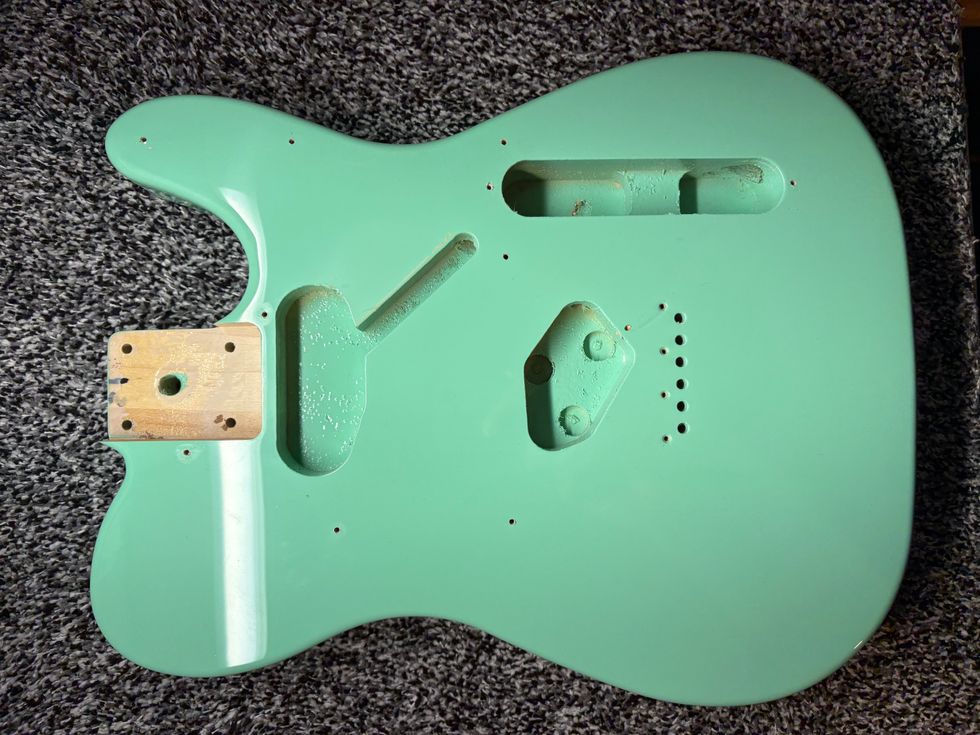
With these qualities in mind, let’s repeat some common internet guitar knowledge (CIGK) and make some assumptions about this instrument:
- A lightweight electric guitar will have no sustain and a thin sound.
- Basswood isn’t tonewood, so it won’t sound very good.
- It’s a multi-piece body, which will make it sound worse.
- The ultra-thick polyurethane finish kills tone because the wood of the guitar can’t breathe and resonate freely.
According to all this online wisdom, we have the worst guitar one can think of, right? Ignoring all these assumptions, one could argue it’s an excellent body because it’s extremely solidly made (stave-glued and laminated), armored under a thick and glass-like layer of ultra-resilient polyurethane finish, yet still lightweight. By the end of our project, we’ll see what’s fact and what’s fiction, but we have plenty of work to do first.
Here is a list of fixable issues to be addressed:
1. There is a lot of paint in almost every hole in the guitar, often paired with fringed wood fibres from the drilling process.
2. There is a lot of wooden debris, primer, and paint in the neck pocket, as well as a 10mm hole.
3. The depth of the bridge pickup’s cavity is relatively shallow.
4. Inside the electronic compartment there is a massive block of wood.
These will be the first steps to enhance the quality of the body, with the first being the easiest one. You don’t need much for this, just some half-round files in different sizes, a countersink, some old newspaper, and, of course, some time.
I assume they used worn-out, blunt drill bits in the factory, which would explain this mess. They first drilled the holes, with little care for the result, then painted over afterwards, preserving all the fringed wooden fibres under a thick layer of paint. Luckily, this is easy to correct. Cover your workspace with some old newspapers, place the body on it, and clean all the holes with a half-round needle file before using a larger one to clean the hole for the output jack.
This was the meanest one on this guitar—I was really surprised how much stuff came out of it after some passes with the file. After all the holes are cleaned and free of any paint and debris, use a sharp countersink to carefully clean the tops of all the holes. Don’t use any machine for this, just a countersink, your hands, moderate pressure, and two passes for every hole. Because the paint is really thick, it’s easy to chip off some color, so it’s important that your countersink is really sharp and you don’t apply too much pressure.
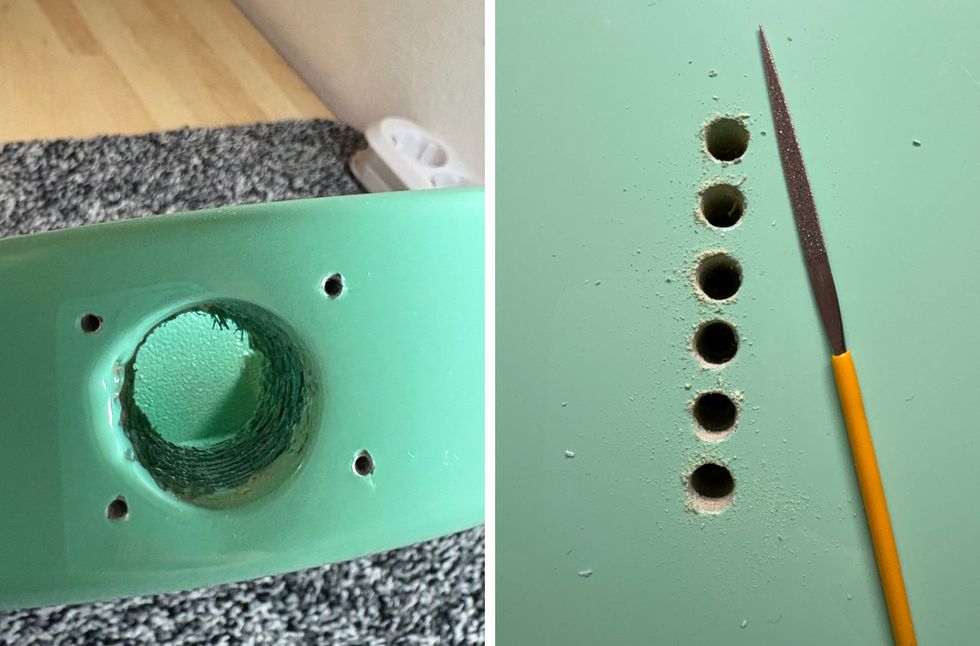
This was a good start! Next month, we will continue with the second task on our list: cleaning the neck pocket, which is a very important step. Stay tuned, and remember, our $352 budget is reduced to $340 because of the new ferrules I bought.
Until next month ... keep on modding!
Own the Reimagined Mark IIC+ HRG, and the New Vintage Thiele Cabinet
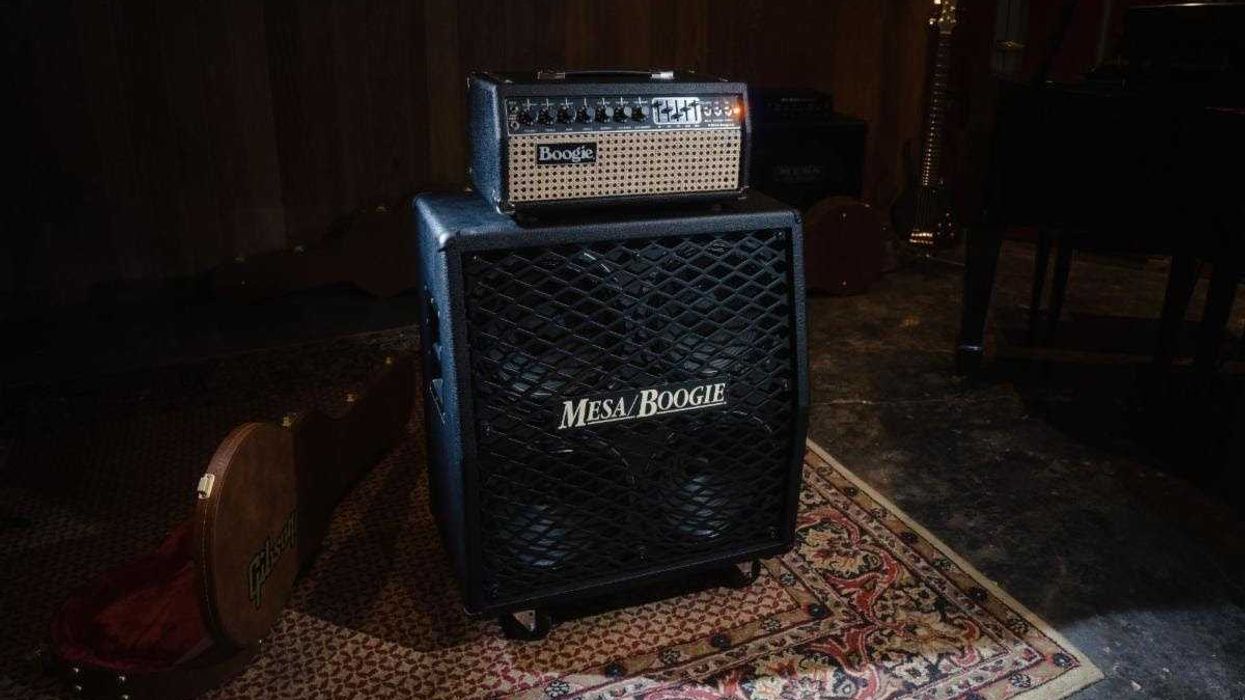
MESA/Boogie is the original boutique Home of Tone, handcrafting amplifiers of uncompromising quality from the world’s finest materials in Petaluma, California, USA. Today, with reverence and pride, MESA/Boogie has announced the arrival of the Mark IIC+ HRG and the return of the 1x12 Vintage Thiele Cabinet. The new MESA/Boogie Mark IIC+ HRG and the 1x12 Vintage Thiele Cabinet are now available worldwide at authorized dealers, Gibson Garage locations, and on www.mesaboogie.com.
“HRG harkens back to the Lagunitas Shop, where Randall Smith built every amp from an expanded menu, offering the ‘Super Sixty’ Boogie as the base model platform to build upon,” says Doug West, Director, Tone Lab, Gibson Amplifiers and MESA/Boogie. “Popular options included Hundred Watts, Reverb, and Graphic EQ, along with solid hardwood cabinetry for added beauty and durability. Using chassis codes during the build process, the two main models became the ‘SRG’ and the more powerful ‘HRG’—the fully loaded amp, sans cabinetry.
We’re excited to bring back this iconic and feature-rich Mark Series, now built on the IIC+ platform for the first time since the production Mark IIIs (and the more recent JP-2C). The result is a beast: it can play clean in Rhythm Mode at high volumes before clipping, and it tracks even tighter than the Simul IIC+ in the low end in Lead Mode, all while brandishing a ferocious ‘claw’ above it all.
With a personality all its own, the IIC+ ‘HRG’ is well worth a test drive for those seeking impressive headroom for clean work, super-tight low end for modern gain sounds, and maximum girth and authority across any style. This ‘Hun’ is no joke!”
Take a deep dive with Doug West into the history of the MESA/Boogie Mark IIC+ HRG: HERE.
MARK IIC+ HRG
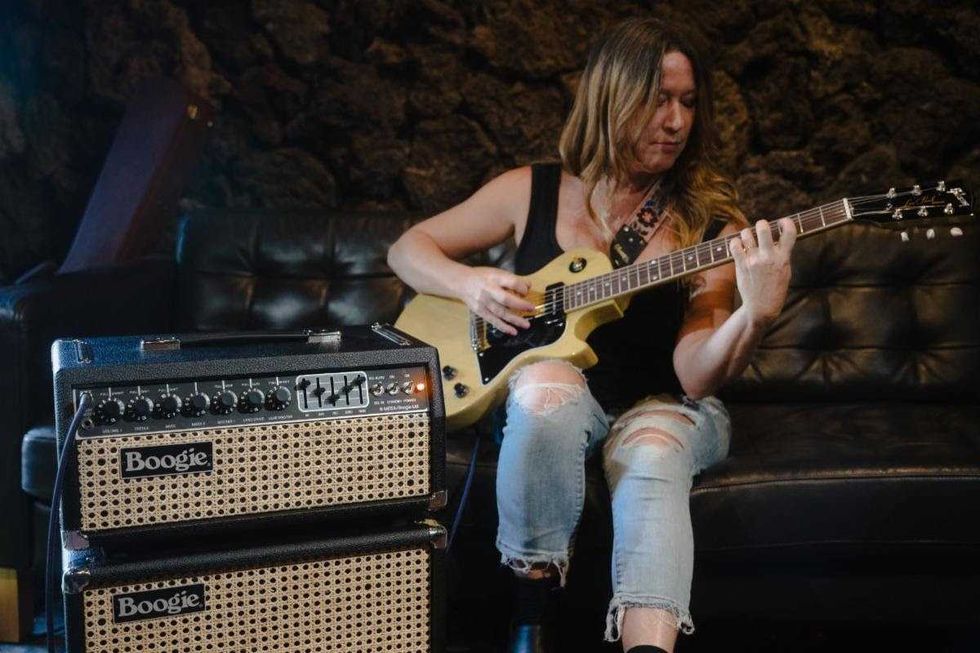
The Mark IIC + sits above the 1x12 Vintage Thiele Cabinet, both pictured in Wicker Grille.
In the history and lore of the Boogie® Mark IIC+, the HRG holds a firm and lofty place. While 75-watt Simul-Class™ builds surpassed both the Super Sixty™ and 100-Watt models in number during the original mid-80s Mark IIC+ production lifecycle, the original Mark I “HRG” format – Hundred-Watt/ Reverb/Graphic EQ, or Hun/Rev/Graph – was always classic Boogie.
With bold authority, maximum headroom, tight tracking low end, and detailed clarity, the HRG became a favorite among those seeking immense clean headroom as well as a truly commanding lead voice. As the years passed and styles evolved, the HRG’s aggressiveness for “crunch” rhythm work earned it a revered place in heavy rock and metal as well. A Mark IIC+ HRG has long been the model of choice for virtuoso guitarist John Petrucci throughout his career with Dream Theater and various solo projects. Hence, this 100-watt model provided the perfect platform for the signature JP2C that MESA partnered with John to create for his performance needs. With one of the most expressive preamps of all time and the mightiest of power sections, the HRG puts an exclamation point on the Mark IIC+ sound that is as exciting as it is unequaled. If your dream amp calls for total authority, knockout punch, and undeniable character, look no further than the mighty Mark IIC+ HRG.
1x12 VINTAGE THIELE CABINET
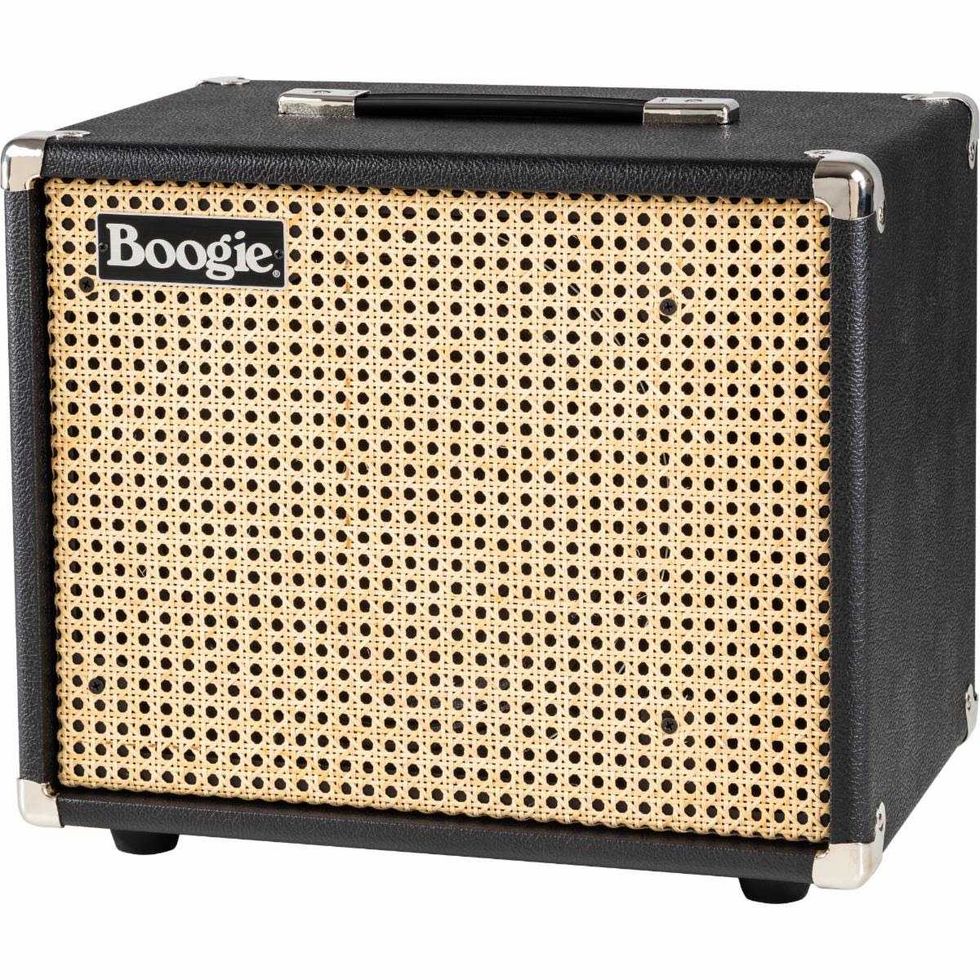
The Mark IIC + sits above the 1x12 Vintage Thiele Cabinet, both pictured in Wicker Grille.
Back by popular demand, fat tone’s secret weapon, the 1x12 Vintage Thiele Cabinet. The seen-everywhere companion to Boogie® combos and small heads in the day, this little cabinet set the tone for compact rigs, club to concert arena, throughout the decade of decadence. This compact, ported 1x12 extension—available in black vinyl grille and wicker grille—is the perfect enhancement to our latest “second build” Mark IIC+ or any Mark Series combo or head and open-back cab rig, adding focused fundamental and thumping, gut-punch low end to those exciting sounds.
While initially designed for an Electro-Voice® EVM12L speaker and introduced (under Boogie banners) in the early 80s, the Thiele’s signature sound and relevance are timeless for anyone wanting to add girth and strategic percussive lows regardless of the amp’s origin or stylistic leanings. Now loaded with our era-appropriate proprietary Celestion® C90 speaker, the 1x12 Thiele delivers more than ample low-end punch yet responds with a forgiving, overdrive-friendly voice that adds today’s heavier styles to its originally versatile can-do list.
“While we’re feeling nostalgic, we wanted to bring back one of the iconic 1x12 Boogie cabinets to celebrate the excitement surrounding the IIC+—the Boogie Thiele 1x12 Extension,” says Doug West, Director, Tone Lab, Gibson Amplifiers and MESA/Boogie. “This sealed and ported design became synonymous with huge tone in the ’80s, when players and artists alike discovered it was a secret weapon for delivering massive low end far beyond its physical footprint, along with a tight, punchy overall sound.
We’re excited to offer this mighty little cab once again, now paired with a more forgiving and era-appropriate speaker—our proprietary Celestion C90—to complement the ‘HRG’ IIC+ and other compact Boogie rigs, especially as easy transport becomes increasingly important to players.”
Stompboxtober 2025: Gator Cases

Go big or go home! Today’s Stompboxtober prize is the Gator Kicker Series large pedalboard—a road-ready rig with space for your entire arsenal. Enter now for a chance to win, and don’t forget to stomp back tomorrow for another giveaway!
Stompboxtober 2025 - Win Pedals All Month Long!
Gator Cases Black Aluminum Pedal Board; Large w/ Carry Bag
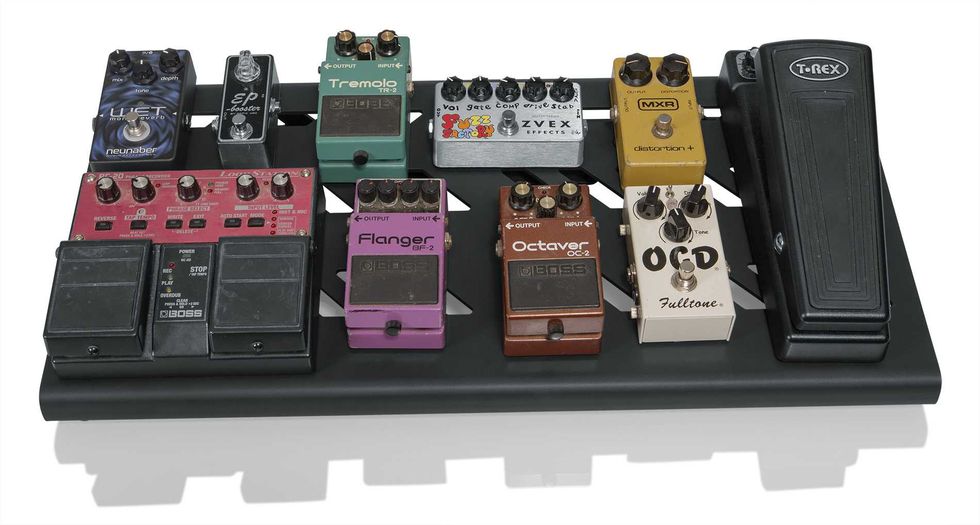
Black Large aluminum pedal board with Gator carry bag and bottom mounting power supply bracket. *Power supply not included.
The Kicker Series Pedalboards bring style and function to your setup with bold color options—black, orange, green, and white. Built from lightweight aluminum, the large board offers a roomy 23.75" x 10.66" surface angled for easy pedal access and designed with cable-routing perforations to keep your rig clean. A universal mounting bracket fits most common power supplies beneath the board, while no-slip rubber feet keep everything stable. Every Kicker board comes ready to hit the stage with adhesive Velcro strips and a deluxe carry bag featuring a reinforced top and bottom, plus a removable shoulder strap. $199.99 Street Price

Gator Large Pedalboard with Bag - 23.75x10.6-inch Black
Bezard Guitars Introduces the Famine 6 Electric Guitar
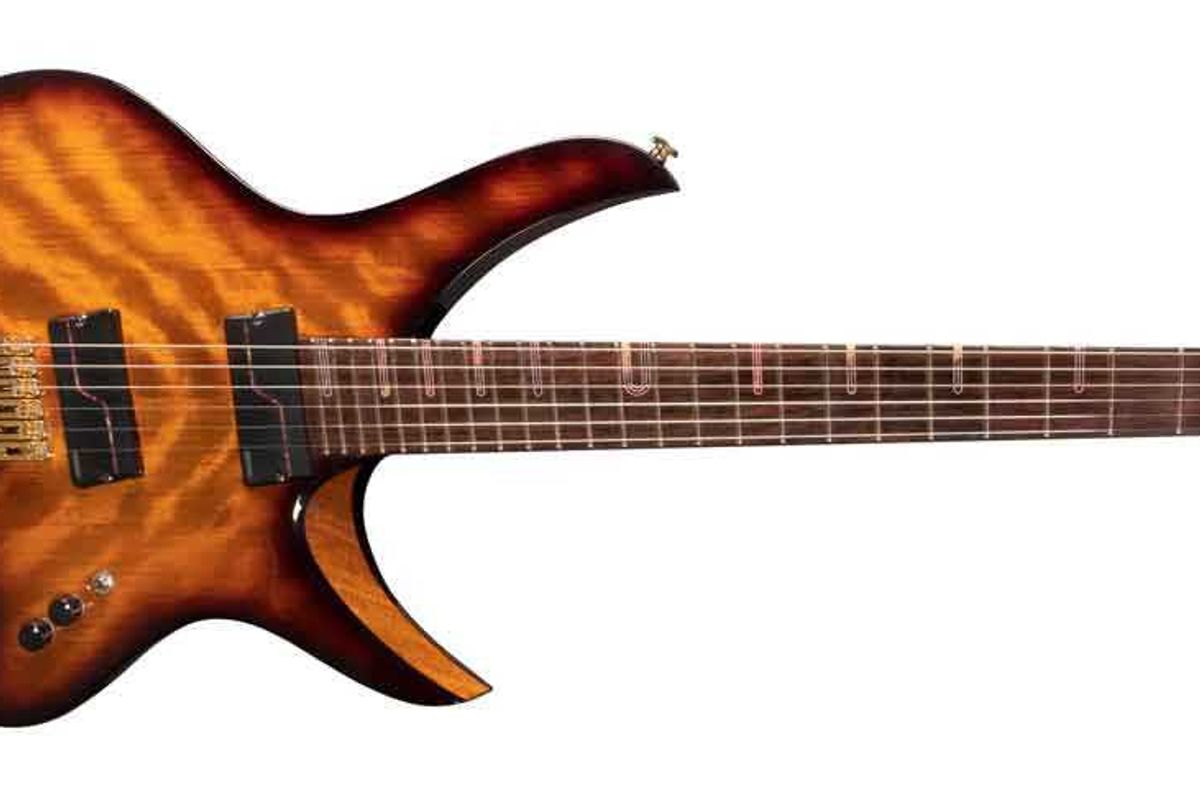
Bezard Guitars has introduced the Famine 6, a striking new electric guitar that is built to be as visually captivating as it is sonically versatile. Its name is derived from the second horseman of the apocalypse, and the Famine 6’s ultra-light, slim design is crafted to melt seamlessly into the player’s body.
The body of the Famine 6 features a carefully chosen blend of tonewoods. Its mahogany body is complemented by Port Orford Cedar decorative veneers, with a tobacco sunburst finish enriched by striking red and gold resin inlay. As each guitar is built to order, other wood options and finishes are available. The back is radiused at 47 inches, while the top carries a 23.5-inch projection radius that mirrors the compound fretboard radius. The neck is a graphite-reinforced mahogany laminate construction, built for strength and stability. It carries a 25.5”–25” multiscale rosewood fretboard with a 12”–20” compound radius, either stainless steel or phosphor bronze fret wire, and a custom brass or aluminum nut, combining durability, smooth playability, and elegant detail.
For electronics, the Famine 6 comes equipped with Fishman Fluence pickups, offering modern tonal versatility and clarity. Once again, as each guitar is custom built, other pickups are available depending on the player’s preference. These are wired to a three-way selector switch with volume and tone controls, providing players with dynamic tonal options suitable for a wide range of styles and genres.
The guitar is finished with gold Hipshot hardware that ensures stability, precision, and a refined aesthetic. Each Famine 6 ships in a form-fitting custom TKL hard case, designed to protect the instrument with the same care and craftsmanship invested in its construction.
The debut of the Famine 6 reflects the vision of luthier Will Bezard, founder of Bezard Guitars. Bezard’s journey began with studies at the Galloup School of Lutherie, followed by six years working alongside the legendary Rick Turner, where he refined his expertise in every facet of guitar construction. Today, he continues his work at Galloup while building his own guitars, blending technical precision with artistic expression. Bezard is dedicated to creating instruments that inspire, endure, and resonate with players on every level.
The Bezard Guitars Famine 6 is available for a base price of $7000 USD. For more information please visit www.bezardguitars.com
Winnipeg’s Living Hour Control the Chaos
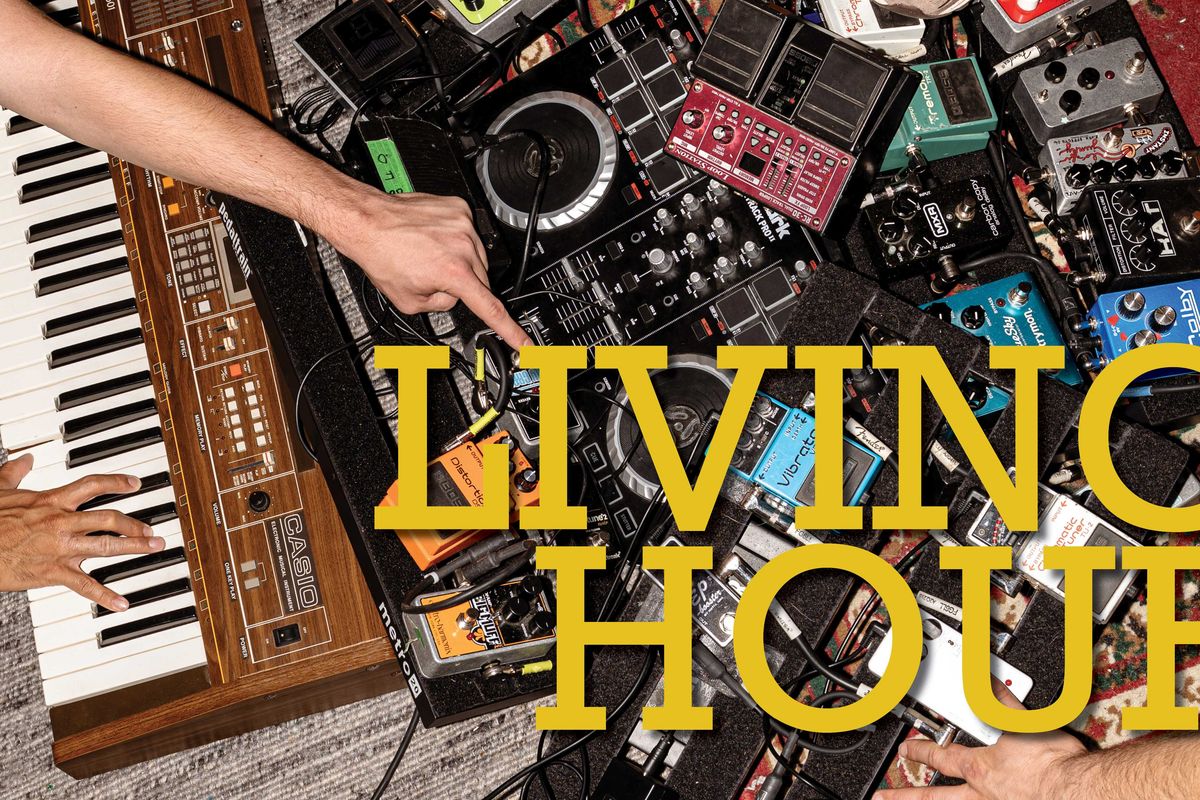
“Stainless Steel Dream,” the leadoff track from Living Hour’s fourth record, Internal Drone Infinity, begins with a manic, glitchy din. The sonic assault ends abruptly, swiftly contained, giving way to a lone bass and singer Sam Sarty's hushed opening lines: “Pink hair straightener, baby, messy messy dresser in a dark room, empty.” Less than 60 seconds goes by before the Winnipeg-based band ascends into a squall of noise and just as quickly calms themselves again. Internal Drone Infinity is defined sonically and lyrically by this tension—the push-and-pull between order and chaos, quiet and loud, inner and outer universes.

“I was thinking a lot about how anxiety and thoughts exist in your body and in the small decisions you make everyday and in what you see in the world,” Sarty says over the phone from her grandfather's house on Vancouver Island. “Your whole life is based on your perception of what you’re seeing. Then I thought about how anxiety and busy thoughts color that and affect it and change your whole life. When I’m feeling really extreme, I think, ‘Oh yeah, you could just die because a bee would buzz into your face and you’d freak out and fall off a cliff or something.’”
A typical response to existential dread is often grasping for control. On Internal Drone Infinity, this manifests in Living Hour’s gravitation toward precision in the midst of turbulence—in moments like the spiralling outro of “Wheel” or the feedback-heavy ease-in to “Big Shadow,” it’s as if the band has simply figured out how to put their hands around noise and turmoil and shape them to their whim. This move toward punchiness and away from the gentler, gauzier sounds of 2022’s Someday Is Today could be attributed to a number of things—the scientific rigor with which guitarists Gil Carroll and Adam Soloway tend to their tones, Sarty’s writing more guitar parts, or Carroll’s shift from mostly clean sounds to incorporating fuzz, distortion, and overdrive. (“Swiss army knife” multi-instrumentalist Brett Ticzon also handles a few guitar details, while drummer Isaac Tate plays one upside down on “Big Shadow”).
“We were kind of inspired by the band Superheaven, who I’m sure play their guitars through these massive stacks and get huge, huge guitar chord tones,” Soloway says. “But we were still working with our little amps, so we would be recording six different guitars doing different versions of a chord to try to make it sound as huge as possible, stacking them on top of each other.”

It’s likely, though, that the most significant change is that Sarty is confronting some of that aforementioned dread defiantly instead of turning away or opting for resignation. “Everyone’s kind of angry, we’re getting pissed, the world is fucked, and sometimes it feels like I can’t just be in a nice indie rock band anymore playing twinkly things,” Sarty says. “It’s still nice to do that, but I think there needs to be a release, a scream or a grunt or something.”
Internal Drone Infinity offers a lot of moments for that kind of release, often in the shape of incredibly sharp, layered, fuzzy freakouts—like on “Firetrap,” a Soloway joint that wrestles with the weight of the onslaught of violent images and videos online, or “Half Can,” which adds Jenna Wittman’s unsettling violin to the commotion.
Sarty’s precise sense of composition, tone, and execution likely stems from an obsessive impulse she’s had since childhood—to photograph and write about whatever catches her eye, whether it’s garbage or cheese. Combined with the fact she was writing these songs while working as a projectionist at Winnipeg’s independent movie theatre (“It’s a really cool job, because you can watch so many movies for free and you feel like a weird, twisted Gremlin”), Sarty has long been tuning her attention to small details, a practice which, like auteur cinema, creates its own dreaminess.
Gil Carroll’s Gear
Guitars
Fender American Telecaster
Epiphone Les Paul
Amps
Fender Vibrolux
Effects
Boss TU-3
Boss VB-2W
JHS 3 Series Distortion
Xotic EP Booster
Strymon Big Sky
Strymon El Capistan
Strings & Picks
Rotosound Roto Reds (.011–.048)
Adam Soloway’s Gear
Guitars
2015 Fender Classic Series ’60s Jazzmaster Lacquer with Mastery bridge
2020 Gibson SG Tribute
Amps
Fender ’68 Custom Deluxe Reverb Reissue
Effects
Boss TU-3
Electro-Harmonix POG
Fairfield Barbershop
Pro Co RAT
EarthQuaker Colby Fuzz
Boss TR-2
MXR Carbon Copy
Strymon Blue Sky
Electro-Harmonix Freeze
ZVex Instant Lo-Fi Junky
Strings & Picks
.88 mm guitar picks
.011-gauge string sets
Sam Sarty’s Gear List
Guitars & Basses
Fender Baritone Telecaster
Squier Jazz Bass
Amp
Ampeg Micro-CL
Effects
Electro-Harmonix Bass Big Muff
Korg Pitchblack XS
Way Huge Echo-Puss
Pro Co RAT
Brett Ticzon’s Gear
Guitar
Gibson SG Tribute
Effects
TC Electronic PolyTune
Electro-Harmonix Op Amp Big Muff
Boss DS-1
Electro-Harmonix Holy Grail
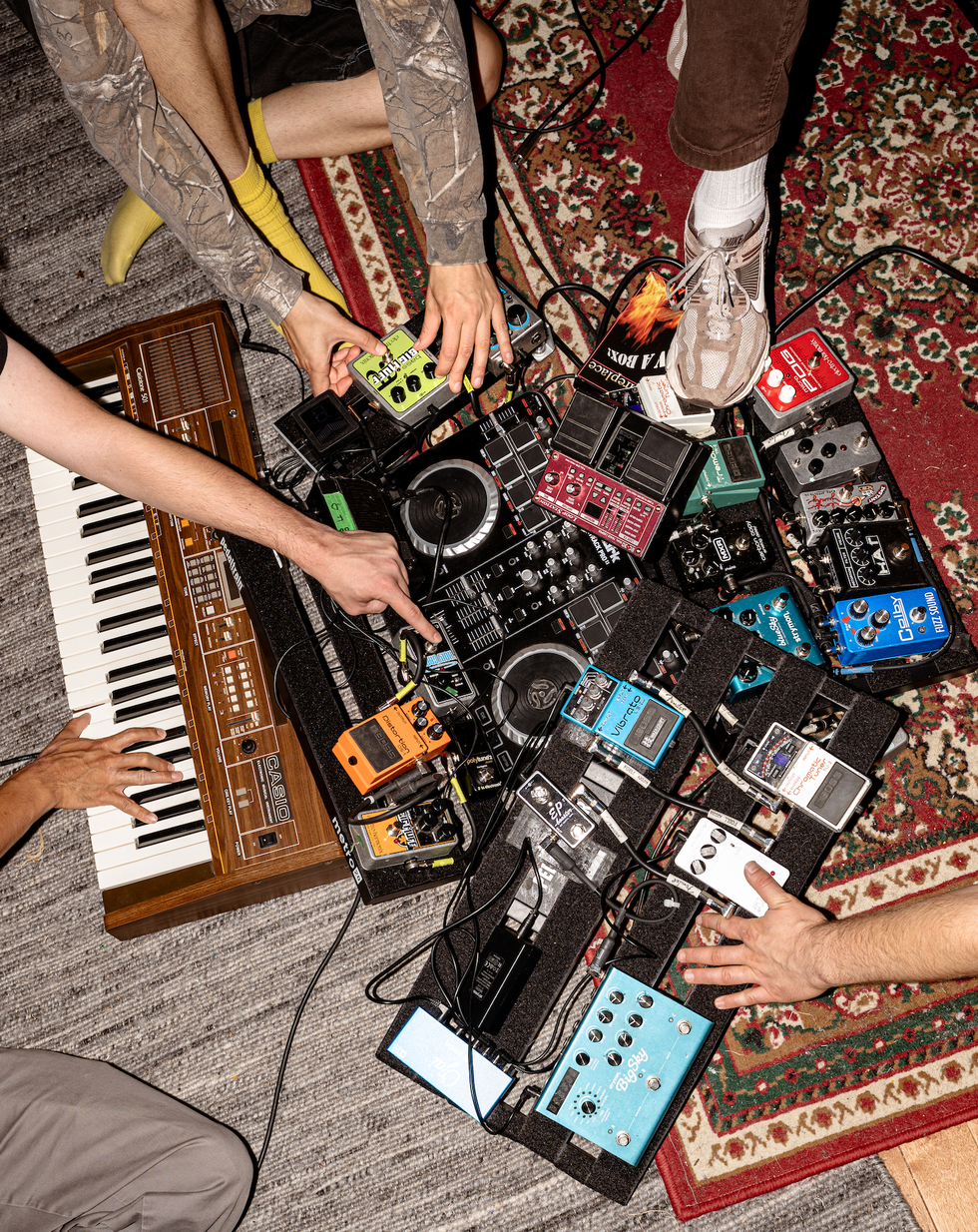
The low-key “Texting” maybe the most pining song on the record—which is saying something for a band that calls their music “yearn-core”—provides a poignant example of this phenomenon. The accumulation of mundane observations produces a strangeness much like that which emerges when you simply gather the seemingly disparate fragments of reality around you: “Sunwashed plastic garbage bin, blue now from the cornflower sun, handles like madonna’s nails; picking zits in Home Depot, and the tread in your shoes.” Elsewhere, there are isolated non-sequiturs (“soft chorus of cellos,” “rabbits looking”) and painful clarity: “I walk home from the movies ’cause I don’t have a car anymore / At 29, I feel sick, but I’m just getting started on my medicine.” It’s kind of like if the poet Mary Oliver had strolled the garbage-strewn and overgrown, busted-concrete back alleys of Manitoba’s capital instead of her peaceful Cape Cod forests.
“‘Texting’ is very much about Winnipeg,” Sarty says. “I was really thinking about moving during Covid, and then after I was like, ‘Okay, it’s my moment.’ But then I can never really leave. It just gets sticky.”
Stickiness—in this case, the stickiness of long-running relationships—is the tacit catalyst in this mixture that’s allowed Sarty to “come into her own as a songwriter” or for the band to record their “funnest album yet,” as Carroll notes. Closeness and intimacy—Carroll lives on the top floor in the same duplex as Sarty, whose apartment is also the band’s jamspace—plus time creates intangible and fluid dynamism. And at this point in their long collaboration, the band members are comfortable with taking the chaos of their 21st-century lives and, with each other’s help, making some order out of it.
“I can imagine a lot of bands struggle with delivering feedback about parts or when they want things to change in a song,” Carroll says. “And obviously we still have those conversations with care, and we’re gentle, but like, Solly can tell me, ‘That tone’s not working.’ Or we can say, ‘Sam, you need to tune your guitar.’ It’s good—that makes the song and the band better, and people are able to receive feedback, which I think has made our songs better, too. It’s like The Rehearsal season two. I’m Captain All-Ears when it comes to my tone.”
Are Widespread Panic the Most Rocking Jam Band?
On the latest episode of 100 Guitarists, we're talking about the great Jimmy Herring with guitarists Rob Compa of the band Neighbor. Here, we discuss Widespread Panic -- are they the rocking-est of all?
Thanks to our sponsor! 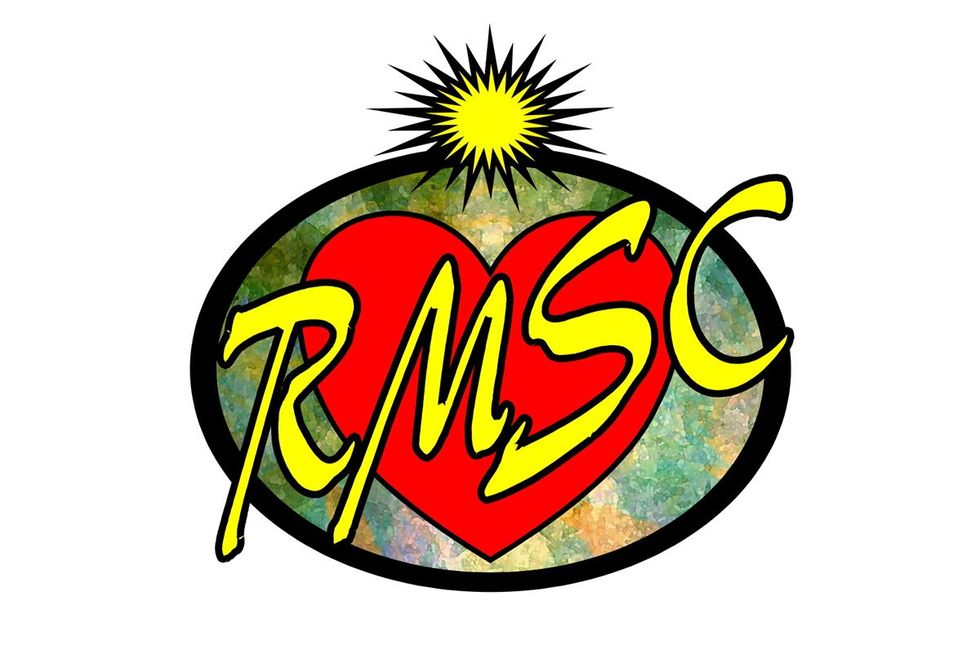 Brought To You By Rocky Mountain Slides www.premierguitar.com
Brought To You By Rocky Mountain Slides www.premierguitar.com
Line 6 Debuts Powercab CL Multi-Voice Guitar Speaker Systems for Amp Modelers
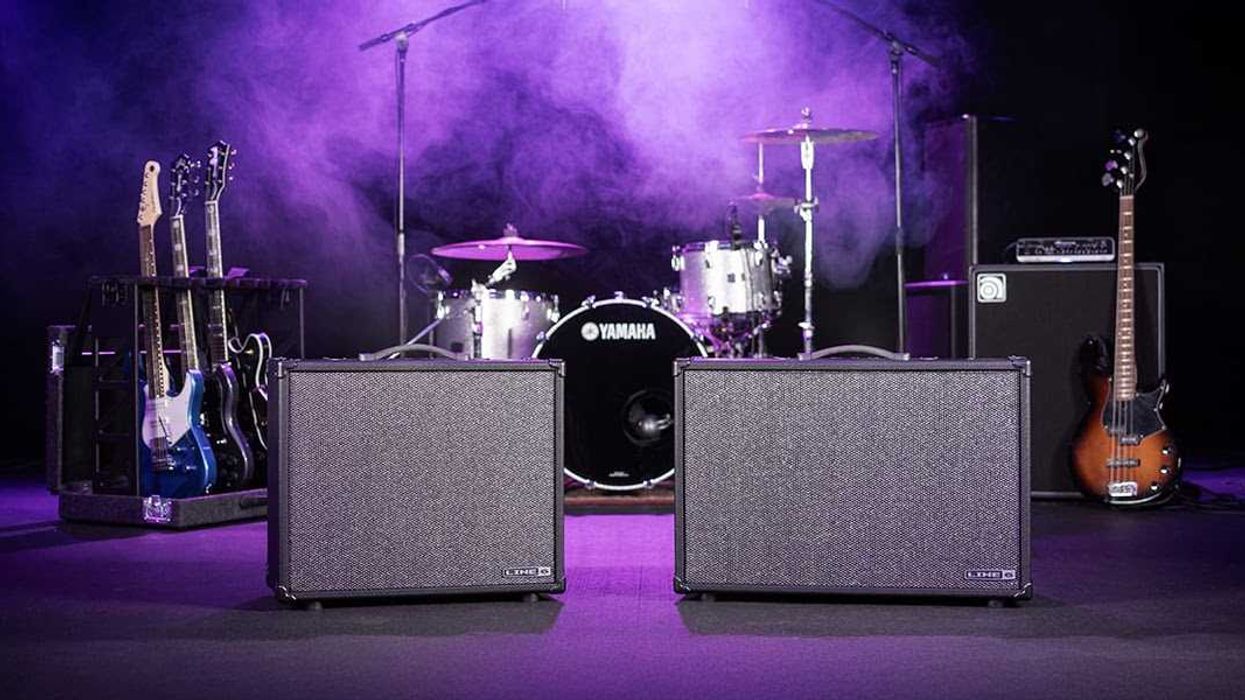
Line 6, Inc. has introduced the Powercab® CL family of open-back multi-voice active guitar speaker systems designed to provide exceptional amplification for all modelers and even compact amp-simulation pedals.
“Both the Powercab CL 212 and Powercab CL 112 are perfect for practice and live performance,” said Rick Gagliano, Senior Director of Products. “Unlike FRFR cabs, they are loaded with custom-designed guitar speakers, providing a playing experience more like plugging into a guitar amplifier with a traditional open-back cabinet.”
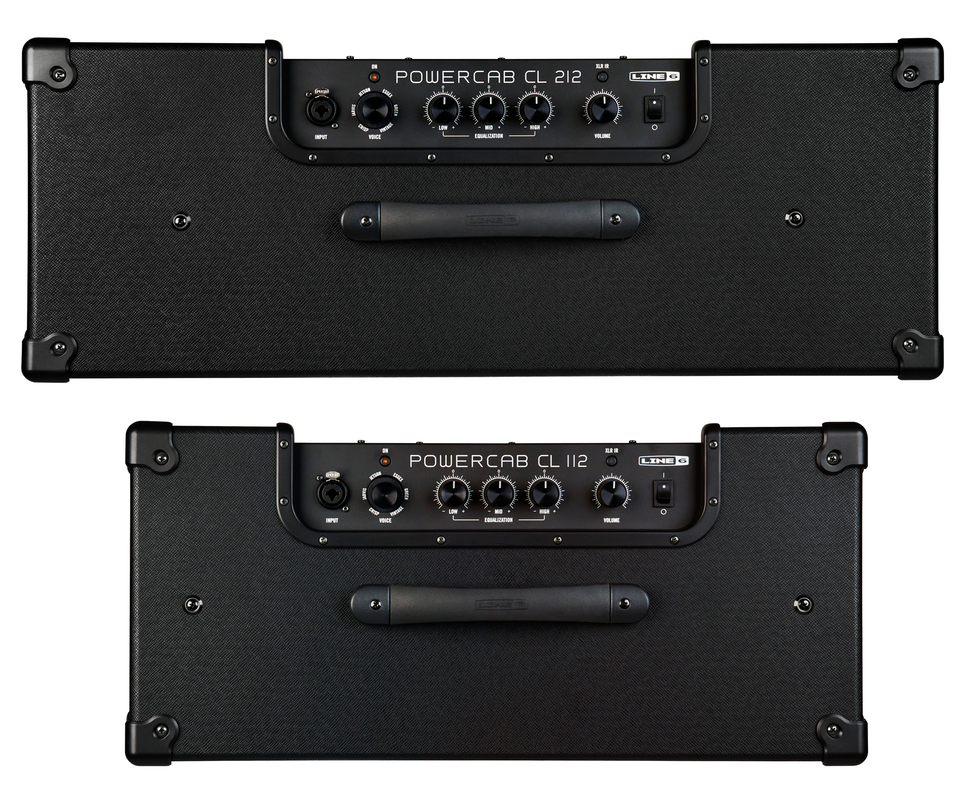
The 200-watt Powercab CL 212 boasts dual 12" speakers, while the 100-watt Powercab CL 112 has a single 12" speaker. These lightweight open-back cabinets feature simple, straightforward controls—including a 3-band room EQ with Low, Mid, and High boost/cut. MIDI control and USB connectivity are also supported. Powercab CL cabs operate in either of two modes:
In Speaker Voicing mode, you can select Speaker Voicings that interact with the internal speakers to make them sound and respond more like one of six legendary speakers. In Power Amp In mode, they function as high-quality powered guitar cabs; In either mode, disable your modeler’s cab block and simply plug in and play.
While in either mode, you can insert a speaker IR into the XLR Out signal, creating an independent virtual cab when routing it to a front-of-house mixer or an audio interface. Six Factory IRs are included, and you can also load your own IRs using the free Powercab CL IR Loader application, select the default/neutral speaker IR, or bypass the IR on the XLR output.
No matter how you use them, Powercab CL speaker systems deliver consistent tone and feel at any volume.
Pricing & Availability
Powercab CL 212 is $549.99 USD (MSRP) and Powercab CL 112 is $449.99 USD (MSRP). Both are available worldwide.
OC Pedal Co. LA HABRA Hard Clipper Review
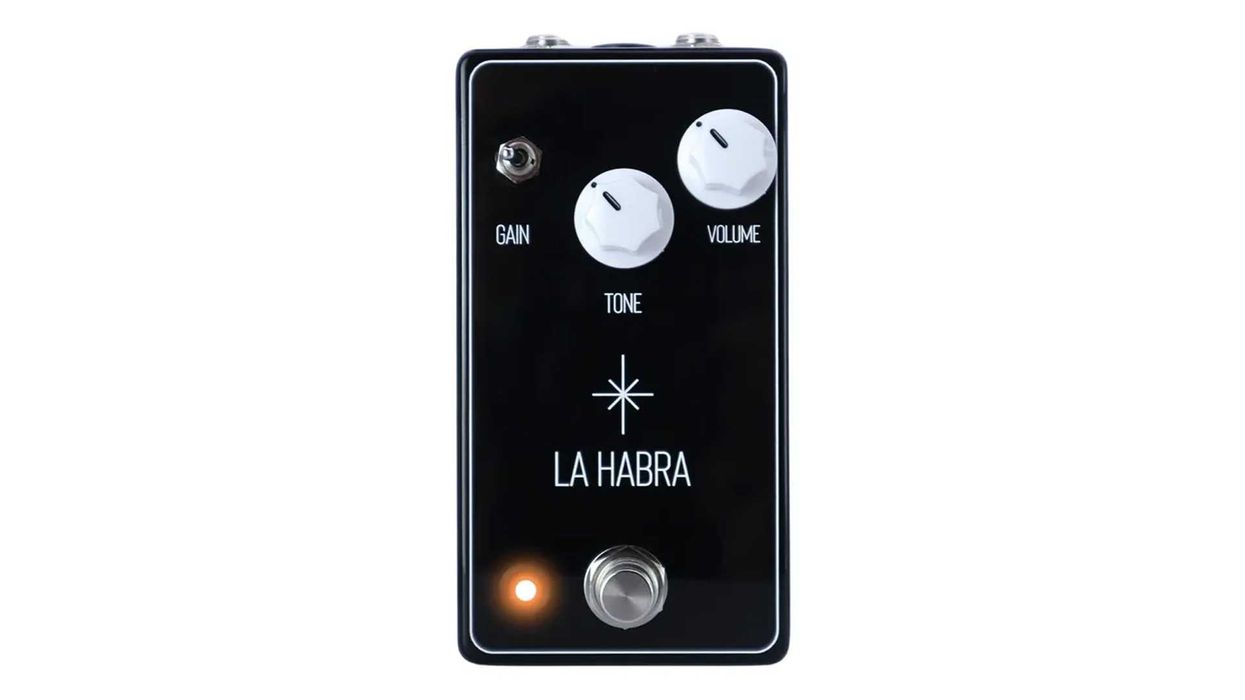
OC Pedal Co. was formed in 2024 by Santa Ana native Evan Haymond, a session ace who toured with Jack Russell of Great White in the 2010s. Not surprisingly, OC Pedal Co.’s U.S.A.-made LA HABRA Hard Clipper evokes many of the crunchy sounds from that era.
Less is More
The LA HABRA’s control panel is minimal, with just two knobs—volume and tone. There’s no gain knob, instead you get a gain switch that lets you choose between two clipping profiles. In the right position the pedal employs op-amp clipping. Set it to the left and a set of LED diodes are activated. With humbuckers, the gain switch set to LED mode, and the tone knob at 11:00, the LA HABRA produced a toothy sound that, sure enough, produced power chord sounds that sounded more than a little like Great White’s cover of “Once Bitten, Twice Shy.”
Though the lack of a gain knob may leave some players feeling limited, the tone knob is a powerful tool for shaping the characteristics of the distortion, and with the tone knob at its darkest setting, the LA HABRA still delivers ample definition. Move the tone knob up to around 3:00, though, and there’s enough clarity and treble detail to make leads sizzle. To my ears this is where the pedal shines, and bumping the tone knob all the way up (with the gain switch still set to the LED clipping mode), the sound is super aggressive without being over-saturated.
In general, with the gain switch set to LED clipping you get a high-end boost and hear and feel more compression. Op-amp clipping tames some of the highs yielding a more balanced output, which is particularly noticeable when the tone knob is set to 3:00 and above. I generally preferred the gain switch set to op-amp clipping but each clipping mode yields sounds that can work in many contexts.
The Verdict
The LA HABRA has plenty of definition for melodic parts and is tough enough for bluesy riffs. For legato shred-type playing, there were times when I wished the pedal had a little more gain. But LA HABRA has a knack for feeling amp-like, particularly in terms of dynamics and touch sensitivity—much more so than many pedals that occupy this mid- to high-mid-gain category.
Mod Garage Guitar Makeover: Neck-Pocket Cleanup and DIY Routing
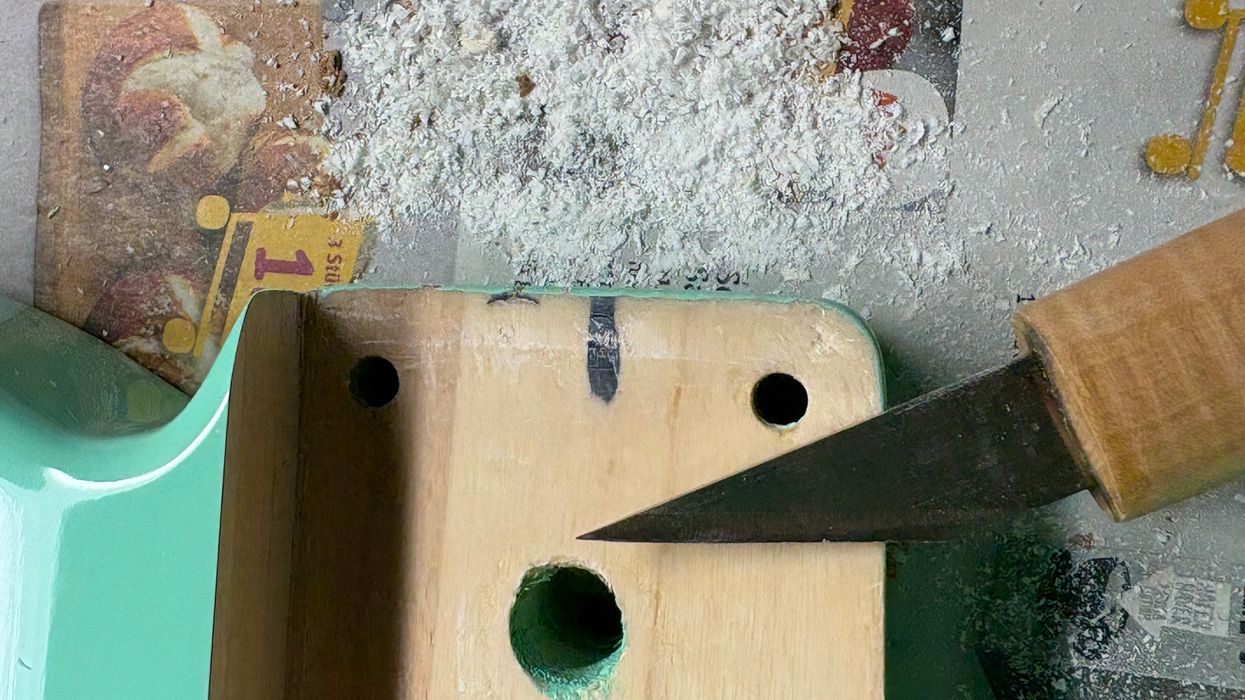
Hello, and welcome back to Mod Garage! Let’s pick up where we left off with our Telecaster.
Our next step will be to take care of the neck pocket, which is a very important and crucial task. This is the contact point of the body and the neck, so we want a tight, precise connection for maximum tuning stability and playing comfort.
I don’t know if it’s the same on all Harley Benton T-styles, but the fitting accuracy of the Harley Benton’s neck and neck pocket is perfect—I wish I saw this kind of quality on guitars which cost more than 10 times the price of this one! No need to modify our neck pocket by gluing in some wooden veneer to make it tighter; we can leave it just the way it is.
While the fitting is commendable, unfortunately the craftsmanship of the neck pocket itself is not that good. Besides wooden debris and chips, there’s a lot of “stuff” inside that I can’t identify for certain, but it’s likely some grain filler and clear coat. We’ll need to remove a fair amount from the neck pocket to ensure the heel of the neck has a completely level surface for installation.
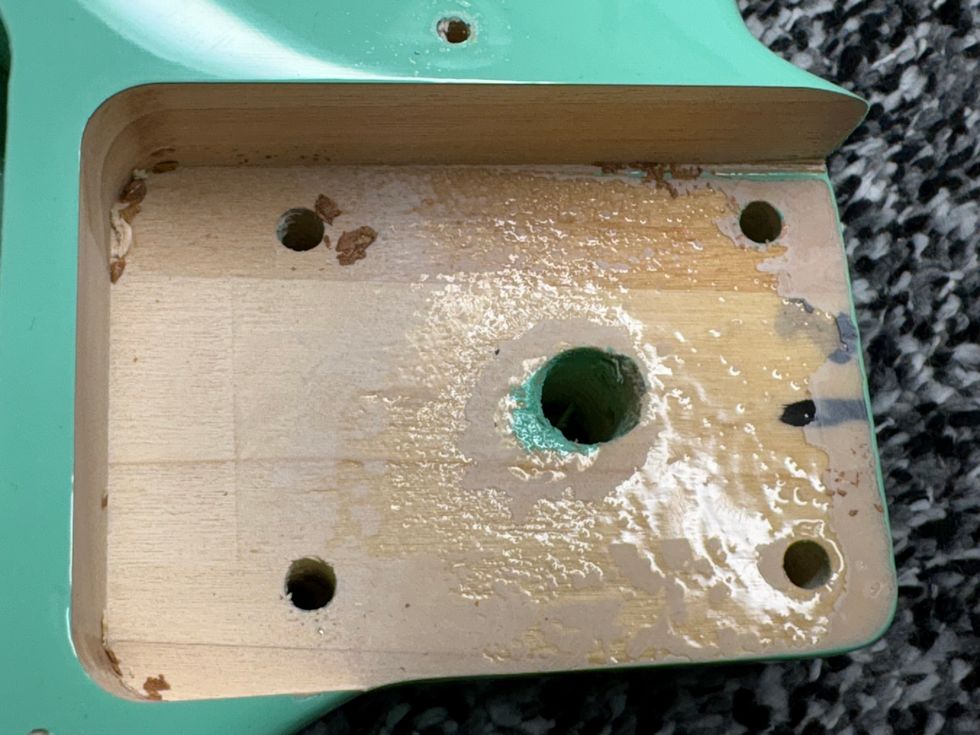
I decided to use a simple razor blade, a Japanese carving knife, and a razor knife to scrape all the junk away. You can also use some micro chisels, or even simply sanding paper. Special knives that are used for guitar lutherie as well as violin-making are ultra-sharp, and with some practice, it’s easy and fast to use them for such tasks. I was surprised by how much material there was in the neck pocket; it had a strong chemical smell to it, so it went immediately into the garbage.

Next, I took some sandpaper of different grits to make the surface as smooth as possible. I started with 150-grit and worked my way up to 1000-grit. After blowing away all dust, the neck pocket was absolutely even and clean, offering the perfect surface for the neck heel. Pleased with the result, I moved on to the next task.
For some reason, there was a big hole in the neck pocket, which I think has something to do with the CNC routing or the painting process. While this hole is not a problem regarding stability, and it’s invisible after the neck is installed, it’s not in the original Fender design, and my inner monk can’t live with this, so it had to be closed with a wooden dowel. After measuring, it turned out to be a metric 10 mm hole, and I knew luck was on my side—as is often the case, IKEA would be my best friend. You’re probably familiar with the bevelled wooden dowels used on almost every IKEA product to attach two parts together. They’re made out of strong beech wood and available as individual spare parts with an 8 or 10 mm diameter, so I always have a good collection in the shop. This was easy going: I simply cut the dowel to length and put it in a cup of warm water for a couple minutes so it expanded a little bit for a tight fit. After drying it for a short time, I put some wood glue on it, plus some in the hole, before pushing it in and wiping away the excess glue with a damp cloth.
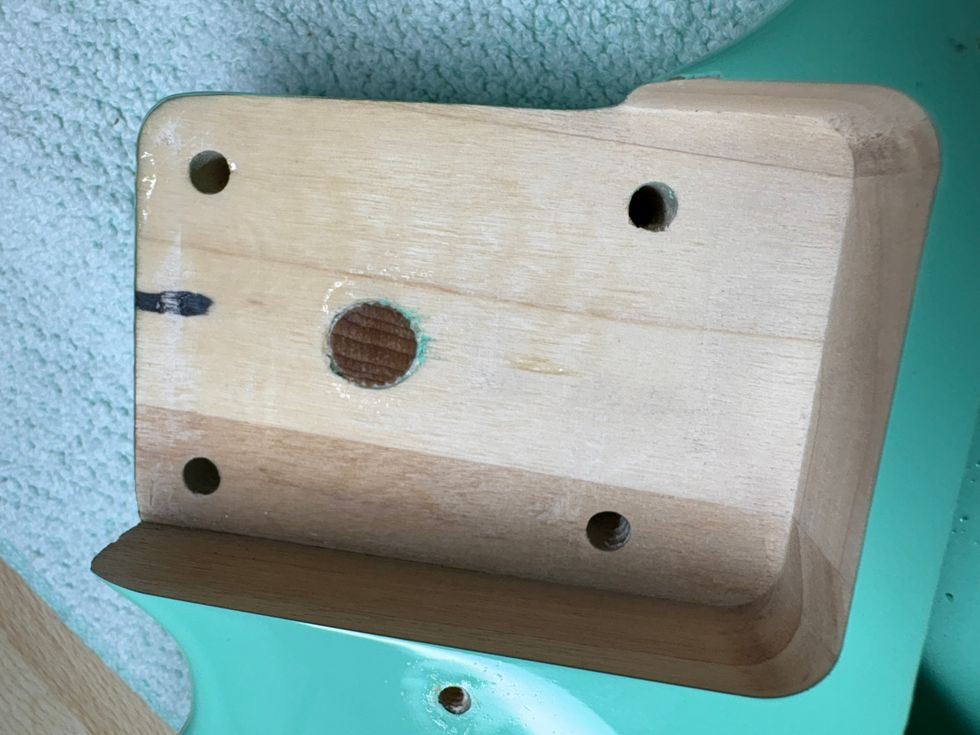
A tip from the shop: Ask your local optical store what they are doing with the old lenses from their customers. If there’s a chance you can get some for free, this is the perfect helper for any glue job—I always have a good collection of such lenses in the shop, and they’re easy to clean with a bit of rubbing alcohol. Put the wood glue on the concave side of the lens and use a toothpick to apply the glue to the dowel and hole. Afterwards, wipe the rest of the glue away, clean the lens with water, and it’s ready for the next time. This also works for super glue, but you’ll have to throw away the lens afterwards.
Here, we can clearly see how many different pieces of wood are glued together for the body (I count four pieces alone in the small neck pocket), that the body is laminated horizontally, and the thickness of the paint.
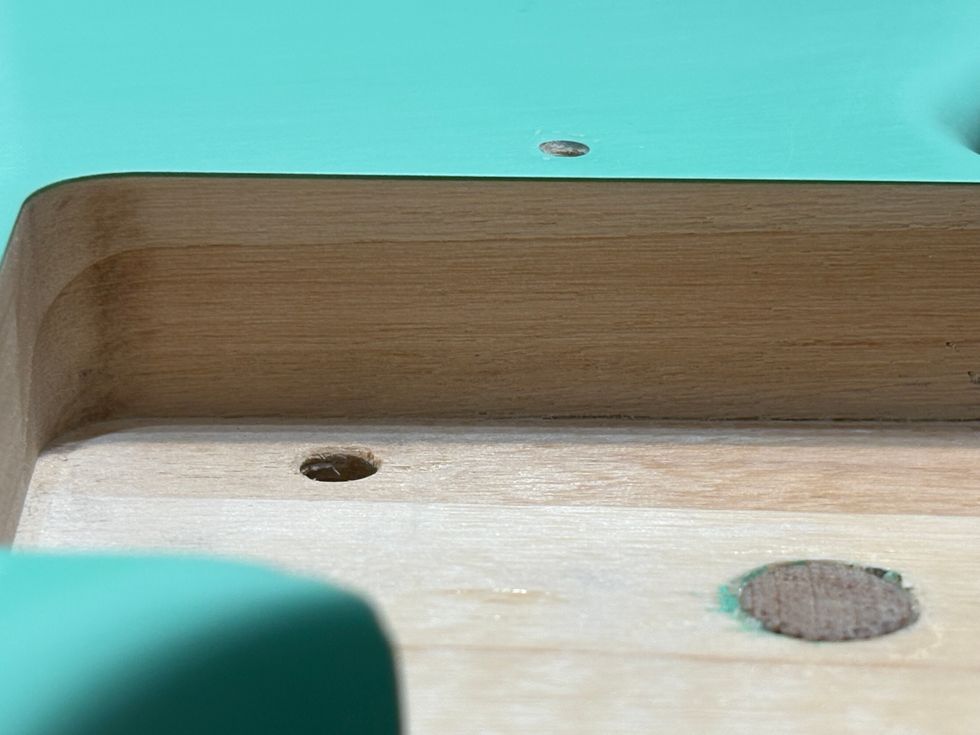
As you can see, the routings for the bridge pickup and the electronics are a little bit strange. The bridge pickup’s cavity is relatively shallow, and a Forstner drill bit was used to create deeper spots for the three screws holding the pickup in place. At the bottom of the electronics compartment is a block of wood, which I’d guess was there to shorten routing time and reduce production costs. I still haven’t decided on the pickups and electronics I’ll use for this guitar, but I certainly don’t want to run into any trouble making them fit. The wooden obstruction here could limit what sorts of pots and pickup-selected switches we can use, so it’s best to get ahead of that and remove it from the equation. (Even if it doesn’t end up being 100 percent necessary, it’ll remove a bit of excess weight!) So, let’s carve out some space here.
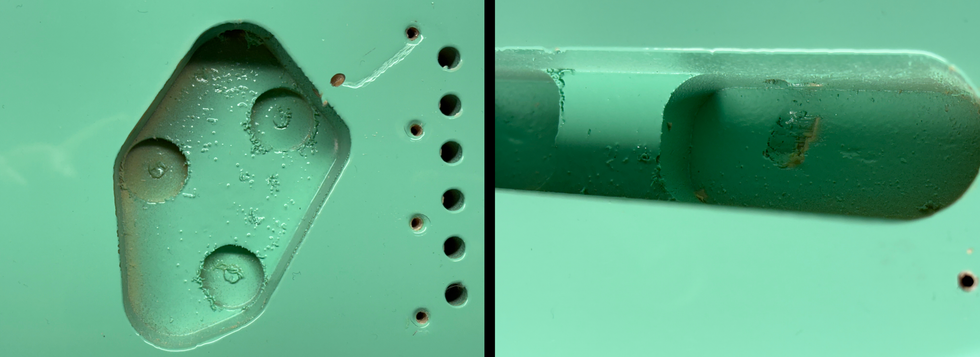
The professional way would be to mask the whole body with tape and use a handheld router to remove the wood. Since I bet most of you don’t have that sort of tool, we’ll do it the old-fashioned way, using a Forstner drill bit and a drill press. I don’t recommend any handheld drilling device for this—if you don’t have access to a drill press or a handheld router, ask your local carpenter if he can do the work for you. After masking the body, the drilling process is easy to do with a sharp Forstner bit. I used a smaller one for the edges and a bigger one for the rest.
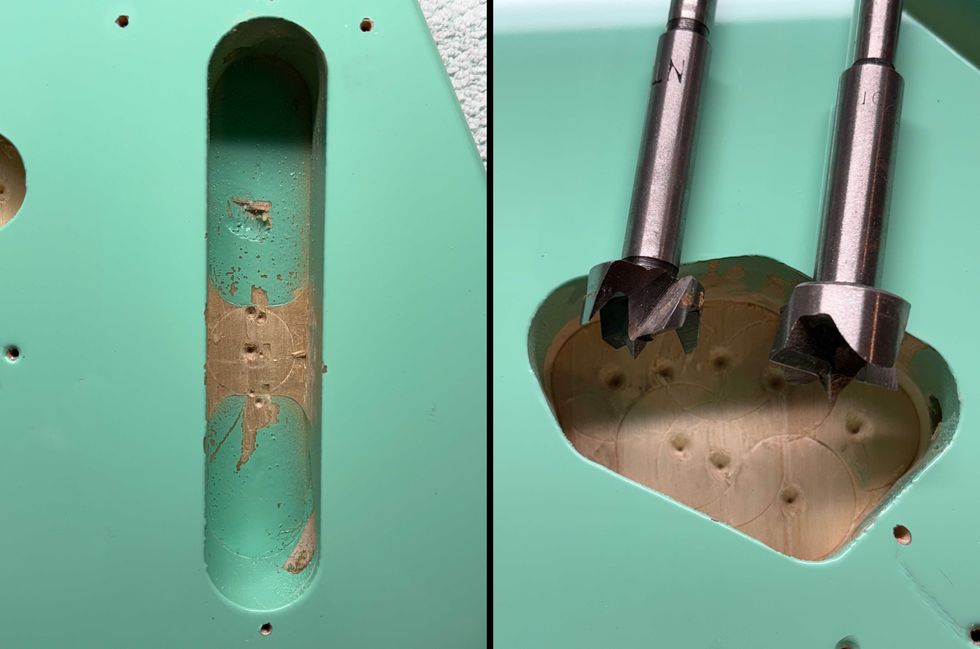
It’s a crude but effective—and fast—way to remove the wood. After the drilling, I used some sandpaper to smooth out the surface and put some shellac on the bare wood, but this isn’t mandatory—my inner monk, you know? Take care to not drill too deep, which happened to me years ago on a custom-made Jaguar body with a very special paintjob. That wasn’t fun to explain to the customer.
Next month, we’ll finish the work on the body, before moving on to the hardware and electronics. The good news is that our $340 budget is still in hand for future investments, so stay tuned.
Mod Garage Guitar Makeover: Neck-Pocket Cleanup and DIY Routing

Hello, and welcome back to Mod Garage! Let’s pick up where we left off with our Telecaster.
Our next step will be to take care of the neck pocket, which is a very important and crucial task. This is the contact point of the body and the neck, so we want a tight, precise connection for maximum tuning stability and playing comfort.
I don’t know if it’s the same on all Harley Benton T-styles, but the fitting accuracy of the Harley Benton’s neck and neck pocket is perfect—I wish I saw this kind of quality on guitars which cost more than 10 times the price of this one! No need to modify our neck pocket by gluing in some wooden veneer to make it tighter; we can leave it just the way it is.
While the fitting is commendable, unfortunately the craftsmanship of the neck pocket itself is not that good. Besides wooden debris and chips, there’s a lot of “stuff” inside that I can’t identify for certain, but it’s likely some grain filler and clear coat. We’ll need to remove a fair amount from the neck pocket to ensure the heel of the neck has a completely level surface for installation.

I decided to use a simple razor blade, a Japanese carving knife, and a razor knife to scrape all the junk away. You can also use some micro chisels, or even simply sanding paper. Special knives that are used for guitar lutherie as well as violin-making are ultra-sharp, and with some practice, it’s easy and fast to use them for such tasks. I was surprised by how much material there was in the neck pocket; it had a strong chemical smell to it, so it went immediately into the garbage.

Next, I took some sandpaper of different grits to make the surface as smooth as possible. I started with 150-grit and worked my way up to 1000-grit. After blowing away all dust, the neck pocket was absolutely even and clean, offering the perfect surface for the neck heel. Pleased with the result, I moved on to the next task.
For some reason, there was a big hole in the neck pocket, which I think has something to do with the CNC routing or the painting process. While this hole is not a problem regarding stability, and it’s invisible after the neck is installed, it’s not in the original Fender design, and my inner monk can’t live with this, so it had to be closed with a wooden dowel. After measuring, it turned out to be a metric 10 mm hole, and I knew luck was on my side—as is often the case, IKEA would be my best friend. You’re probably familiar with the bevelled wooden dowels used on almost every IKEA product to attach two parts together. They’re made out of strong beech wood and available as individual spare parts with an 8 or 10 mm diameter, so I always have a good collection in the shop. This was easy going: I simply cut the dowel to length and put it in a cup of warm water for a couple minutes so it expanded a little bit for a tight fit. After drying it for a short time, I put some wood glue on it, plus some in the hole, before pushing it in and wiping away the excess glue with a damp cloth.

A tip from the shop: Ask your local optical store what they are doing with the old lenses from their customers. If there’s a chance you can get some for free, this is the perfect helper for any glue job—I always have a good collection of such lenses in the shop, and they’re easy to clean with a bit of rubbing alcohol. Put the wood glue on the concave side of the lens and use a toothpick to apply the glue to the dowel and hole. Afterwards, wipe the rest of the glue away, clean the lens with water, and it’s ready for the next time. This also works for super glue, but you’ll have to throw away the lens afterwards.
Here, we can clearly see how many different pieces of wood are glued together for the body (I count four pieces alone in the small neck pocket), that the body is laminated horizontally, and the thickness of the paint.

As you can see, the routings for the bridge pickup and the electronics are a little bit strange. The bridge pickup’s cavity is relatively shallow, and a Forstner drill bit was used to create deeper spots for the three screws holding the pickup in place. At the bottom of the electronics compartment is a block of wood, which I’d guess was there to shorten routing time and reduce production costs. I still haven’t decided on the pickups and electronics I’ll use for this guitar, but I certainly don’t want to run into any trouble making them fit. The wooden obstruction here could limit what sorts of pots and pickup-selected switches we can use, so it’s best to get ahead of that and remove it from the equation. (Even if it doesn’t end up being 100 percent necessary, it’ll remove a bit of excess weight!) So, let’s carve out some space here.

The professional way would be to mask the whole body with tape and use a handheld router to remove the wood. Since I bet most of you don’t have that sort of tool, we’ll do it the old-fashioned way, using a Forstner drill bit and a drill press. I don’t recommend any handheld drilling device for this—if you don’t have access to a drill press or a handheld router, ask your local carpenter if he can do the work for you. After masking the body, the drilling process is easy to do with a sharp Forstner bit. I used a smaller one for the edges and a bigger one for the rest.

It’s a crude but effective—and fast—way to remove the wood. After the drilling, I used some sandpaper to smooth out the surface and put some shellac on the bare wood, but this isn’t mandatory—my inner monk, you know? Take care to not drill too deep, which happened to me years ago on a custom-made Jaguar body with a very special paintjob. That wasn’t fun to explain to the customer.
Next month, we’ll finish the work on the body, before moving on to the hardware and electronics. The good news is that our $340 budget is still in hand for future investments, so stay tuned.
Rush Announce 2026 Reunion Tour

Rock and Roll Hall of Fame® Inductees, GRAMMY® Award-nominated icons, and RUSH Co-Founders Geddy Lee [bass, keys, vocals] and Alex Lifeson [guitar, vocals] have announced their return to the stage for a very special 2026 headline tour, Fifty Something, in celebration of RUSH’s music, legacy, and the life of late drummer and lyricist Neil Peart. It notably marks the first time Lee and Lifeson have toured together in eleven years since the finale of RUSH’s R40 Tour on August 1, 2015 at the Forum in Los Angeles, CA, bringing it full circle with a return to the Forum to embark upon these special shows.Of the tour, Geddy Lee says:
“It’s been over 10 years since Alex and I have performed the music of RUSH alongside our fallen bandmate and friend Neil. A lifetime’s worth of songs that we had put our cumulative hearts and souls into writing, recording and playing together onstage. And so, after all that has gone down since that last show, Alex and I have done some serious soul searching and come to the decision that we fucking miss it, and that it’s time for a celebration of 50-something years of RUSH music. So in 2026, my BFF Lerxst (aka Alex Lifeson) and I are going to hit the road once again to pay tribute to our past and to Neil by performing a vast selection of RUSH songs in a handful of cities. No small task, because as we all know Neil was irreplaceable.
Yet life is full of surprises, and we have been introduced to another remarkable person; an incredible drummer and musician who is adding another chapter to our story while continuing her own fascinating musical journey. Her name is Anika Nilles, and we could not be more excited to introduce her to our loyal and dedicated RUSH fanbase, whom, we know, will give her every chance to live up to that near impossible role. Before we hit the stage, we also hope to add another musician or two to expand our sound a wee bit and free up Alex and I, in order to show off some of our new fancy dance steps.
Lerxst, Anika and myself, along with many of our longstanding crew members have been hard at work rehearsing and designing the kind of RUSH show you’ve grown accustomed to expect from us. We dearly hope you will come along and help us celebrate our history together.”
Carrie Nuttall-Peart and Olivia Peart, Neil’s widow and daughter share:
“We are thrilled to support the Fifty Something tour, celebrating a band whose music has resonated and inspired fans for generations, and to honor Neil’s extraordinary legacy as both a drummer and lyricist.
Neil’s musicianship was singular. Compositions of intricacy and power that expanded what rhythm itself could express. As both drummer and lyricist, he was irreplaceable. Inimitable in his artistry, and unmatched in the depth and imagination he brought to the lyrics that inspired and moved so many, he profoundly shaped how fans connected with him and the band, giving voice and meaning to their own lives.
As the band enters this new chapter, it promises to be truly unforgettable. We are excited to see how their new vision unfolds, and to hear this legendary music played live once again.”
Earlier today, fans got the news via a Rush newsletter from a home video that announced the celebration of upcoming dates with Geddy Lee and Alex Lifeson at Geddy Lee’s home studio. Watch here.Last night the band celebrated in a private event at the Rock & Roll Hall of Fame in Cleveland with this on-stage interview and Q&A. Watch full clip here.RUSH will perform multiple shows in 7 cities across Canada, the United States and Mexico, beginning June 7, 2026 at The Kia Forum in Los Angeles. These special “evening with” shows will find the band playing two sets each night. Each show will feature a distinct selection of songs and RUSH will build each night’s setlist from a catalogue of 35 songs including their greatest hits and fan favorites.
For Fifty Something, Lee and Lifeson will be accompanied by German drummer, composer, and producer Anika Nilles, who has performed as Jeff Beck’s drummer for over 60 shows and has released four solo albums.
Fans will be able to participate in the RUSH Artist Presale by signing up at https://livemu.sc/rush by Thursday, October 9 at 11:59pm ET.
Artist Presales for this tour are hosted by multiple ticketing sites but anyone who signs up can join the sale. For Artist Presales on Ticketmaster, no code is needed – access is tied to your account. The Artist Presale on SeatGeek for Cleveland will require a code. The Artist Presale begins on Monday, October 13 at 12PM local time in the US and Canada and Thursday, October 16 at 12PM local time in Mexico. General onsale begins here on Friday, October 17th at 12pm local time for the US & Canada, and 11am local time for Mexico.
Additionally, these pre-sales will be available:
- Citi for US shows: Citi is the official card of the RUSH 2026 tour. Citi cardmembers will have access to presale tickets in the US beginning Friday, October 10 at 12pm local time until Sunday, October 12 at 11:59pm local time through the Citi Entertainment program. For complete presale details visit www.citientertainment.com.
- American Express for Canada: American Express® Card Members can purchase tickets for the Toronto show before the general public beginning Friday, October 10 at 12pm local time through Sunday, October 12 at 11:59pm local time.
- Banamex for Mexico City: Banamex cardholders will have presale access ahead of the general onsale. Times vary based on Banamex card type, see list below for more details.
- (BEYOND BANAMEX): Presale available Monday, 10/13 9:00 AM local to 11:59 PM local
- (ELITE BANAMEX): Presale available Tuesday, 10/14 9:00 local to 11:59 PM local
- (ALL CARDS): Presale available Wednesday, 10/15 11 AM local to 11:59 PM local
Rush invites fans to get closer than ever with three elevated offerings: an all-new VIP program, the first-ever 2112 Platform Experience, and curated Travel Packages for fans making a trip to see the show.
For VIP: http://wearesuper.co/rushvip
For Travel: http://wearesuper.co/rushtravel
TOUR DATES
Sun Jun 07 Los Angeles, CA Kia ForumTue Jun 09 Los Angeles, CA Kia Forum
Thu Jun 18 Mexico City, MX. Palacio de los Deportes
Wed Jun 24 Fort Worth, TX Dickies Arena
Fri Jun 26 Fort Worth, TX Dickies Arena
Thu Jul 16 Chicago, IL United Center
Sat Jul 18 Chicago, IL United Center
Tue Jul 28 New York, NY Madison Square Garden
Thu Jul 30 New York, NY Madison Square Garden
Fri Aug 07 Toronto, ON Scotiabank Arena
Sun Aug 09 Toronto, ON Scotiabank Arena
Thu Sep 17 Cleveland, OH Rocket Arena
Additionally, RUSH just revealed the 50-track super deluxe anthology, RUSH 50, that Rolling Stone called “an epic saga, that functions equally well as an introduction for the uninitiated or a companion piece for the super fan.” RUSH 50 is available in five distinct configurations, including the (1) Super Deluxe Edition, (2) RUSH Store Exclusive Super Deluxe Edition, (3) 7-LP Deluxe Edition, (4) 4-CD Deluxe Edition, and (5) Digital Edition. It represents breadth of their discography, beginning with the first-ever reissue of their 1973 debut single and concluding with a live recording the final song Lee, Lifeson, and Peart played together during the R40 Tour closer at The Forum. Purchase HERE.
Get ready to celebrate the music of RUSH with Lee and Lifeson live in 2026!
Stompboxtober 2025: NUX

Things are heating up this Stompboxtober! Enter today for your chance to WIN the Fireman high-gain distortion pedal from NUX!
Stompboxtober 2025 - Win Pedals All Month Long!
NUX Fireman
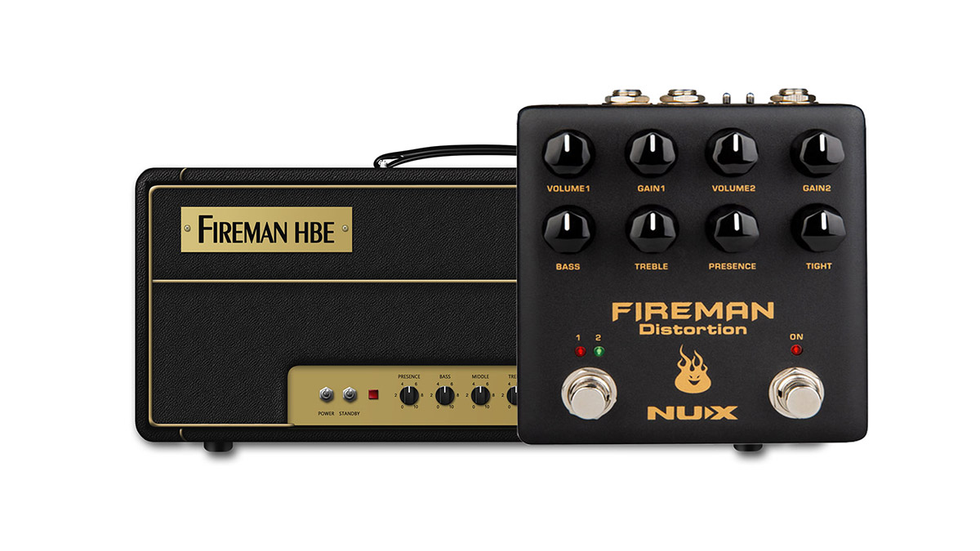
FIREMAN is based on the legendary amplifier builder’s famous distortion pedal. It’s a very amp-like distortion pedal with Modern Brown Sound. We designed it with 2 independent VOLUME, GAIN control knobs to fit rhythm and solo applications. FIREMAN offers a True-bypass / Buffer-bypass toggle switch, and a 9V / 18V toggle switch. The 18V position doubles the working voltage inside to give you wider dynamic range.
A Father’s Cherry Wood Becomes a One-of-a-Kind T-Style
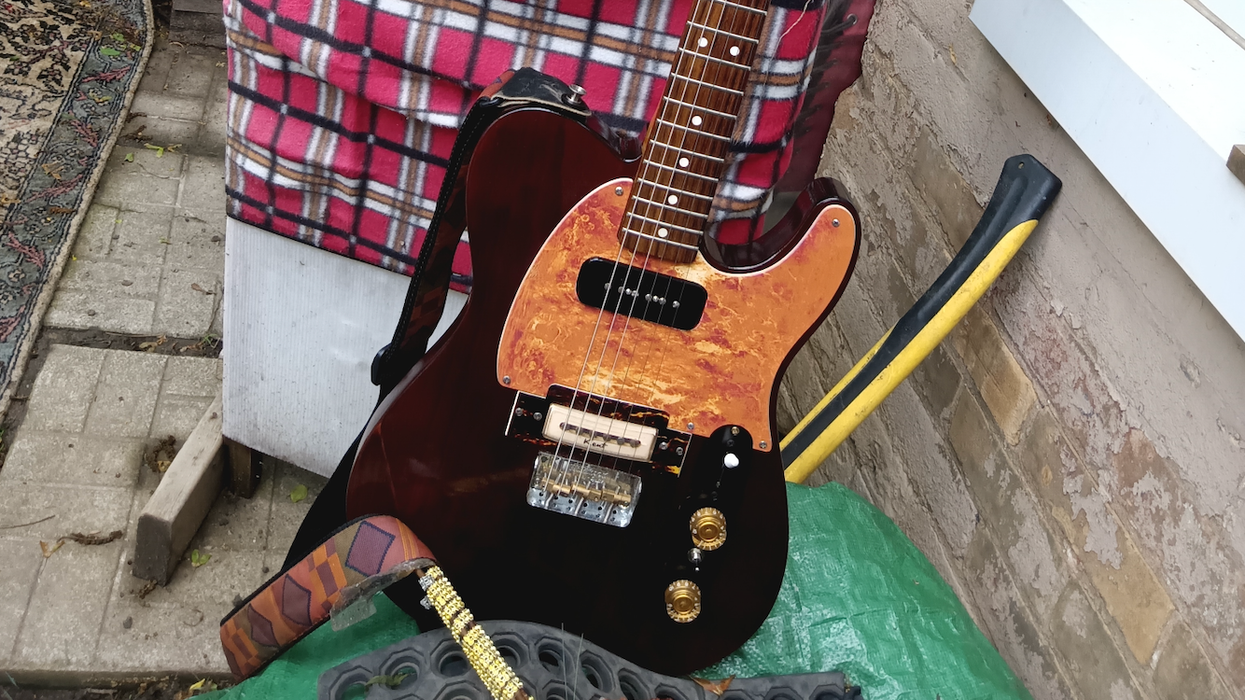
My dad, Al, was a skilled carpenter who did all manner of woodworking, including reproductions, cabinetry, and custom jobs. In the early ’70s, he and my uncle Bruno harvested a pile of walnut and cherry logs at a sawmill in Erin, Ontario. I went along, and it was a fantastic experience. The entire mill, both the main rip and cutoffs, was powered by a John Deere two-cylinder tractor with a 20-foot belt attachment. Wow!
Reader: Kirk Gresser
Hometown: Brantford, Ontario
Guitar: Alcaster
The planks were stored at my uncle John's farm for 10 years, and two brothers who assumed the business name Flintstone and Kramden (honoring Jackie Gleason, of course) decided to use them, along with butternut they purchased, to make a series of grandfather clocks. The guts of the clocks were from Germany, so they were costly, and then Ethan Allen came along and that was that for the clock business. Still, they made quite a few clocks, and by the time they were done there were just a few planks of the original wood left over. After my Dad passed I inherited three of them.
I wanted to use them to build a guitar, but having no experience in that world, I reached out to a talented local luthier, Jesse Livingstone. I gave him the cherry planks to shape the body, which would be his first electric-oriented project. I wanted a T-style but tend to find traditional Telecaster bodies chunky, so I used a 1/4" thinner Squier Telecaster as a template. Jesse also carved a Stratocaster-like belly and forearm cuts, and so the body feels much more like my Stratocasters—in other words, perfect.
“I wanted a T-style but tend to find traditional Telecaster bodies chunky, so I used a 1/4" thinner Squier Telecaster as a template.”
An inventive local amp repairman, Pete Vanderveen, installed the rosewood Squier neck, and stuck a Seymour Duncan P-90 in the neck position and a ’60s Kent single coil, which reminded me of an old Kelvinator refrigerator handle, in the bridge. The Wilkinson bridge enables stringing through the body or as a top-loader, and two Gibson speed knobs serve as volume controls for each pickup. Pete also installed a series/parallel switch.
The pickguard, made by Greasy Grooves, is designed to resemble rust. I had hoped to match the cherry red of George Gobel’s Gibson L-5 but couldn’t find the exact color, so I used burgundy leather dye and five coats of lacquer. The result, which I call the “Alcaster,” looks like black cherry. The whole guitar comes in at a light 7.5 pounds. With D'Addario .011-.049s, the guitar delivers a Les Paul-like tone on the neck pickup, while the combined sounds go from round to Howlin’ Wolf.
As for me? I've been writing songs for 50 years (not one of them has bought me so much as a cup of coffee) under the name Purple Joe. Imagine Mark Knopfler, Jimi Hendrix, and Neil Young playing poker with Scott Merritt and Carole King—and losing!
Stompboxtober 2025: Eventide

Stompboxtober is still going strong! Enter today’s giveaway for your chance to WIN the lush and legendary TriceraChorus from Eventide!
Stompboxtober 2025 - Win Pedals All Month Long!
Eventide TriceraChorus
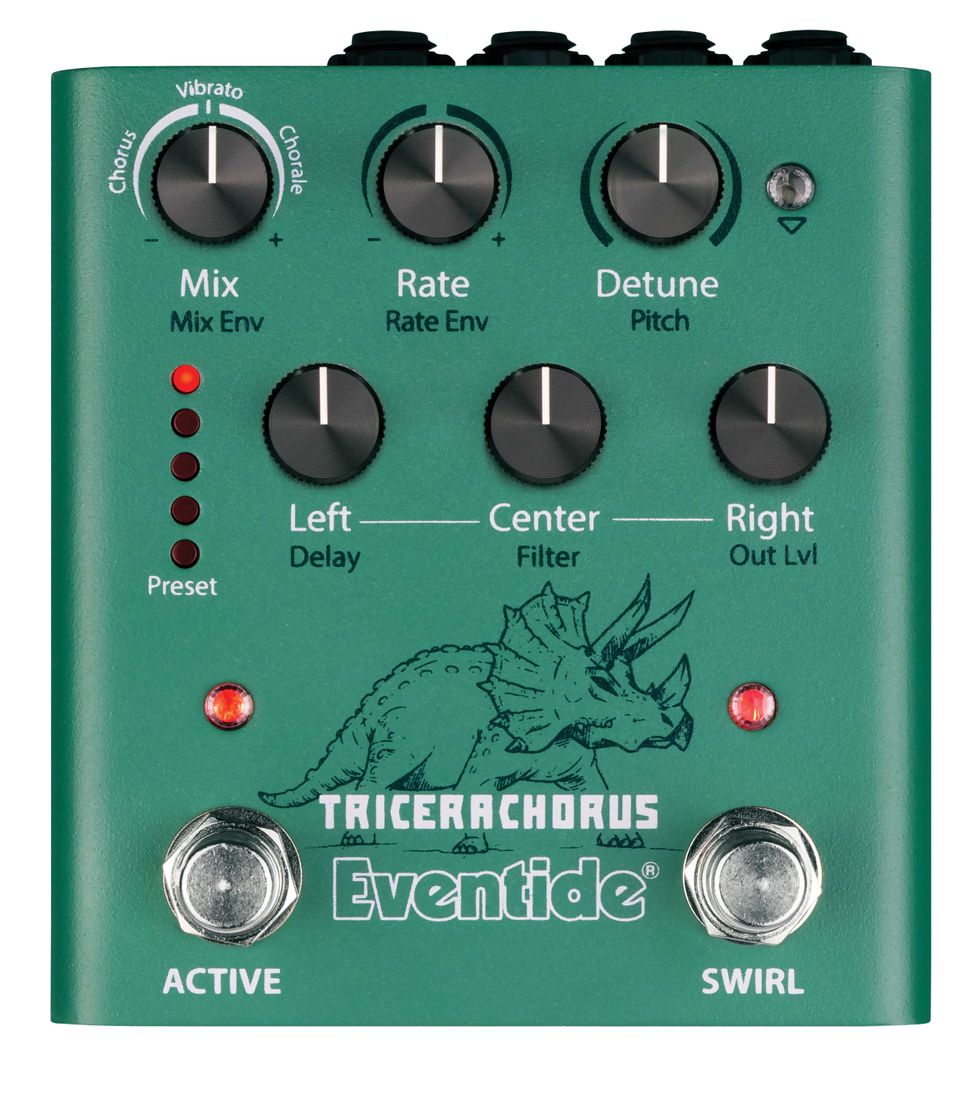
Inspired by the classic Tri-Stereo Chorus and stompbox choruses of the 1970s and early 1980s, the TriceraChorus pedal pairs rich Bucket Brigade-style chorusing with Eventide’s legendary MicroPitch detuning for a lushness that rivals the jungles of the late Cretaceous Period. TriceraChorus features three chorus voices and three unique chorus effects which can be used to create a wide stereo spread with pulsing waves of modulation. The innovative “Swirl” footswitch adds psychedelic flanging, phasing, and Univibe-style tones. It has never been easier to dial in syrupy smooth, deep modulation on guitar, bass, synths, strings, vocals, and more.
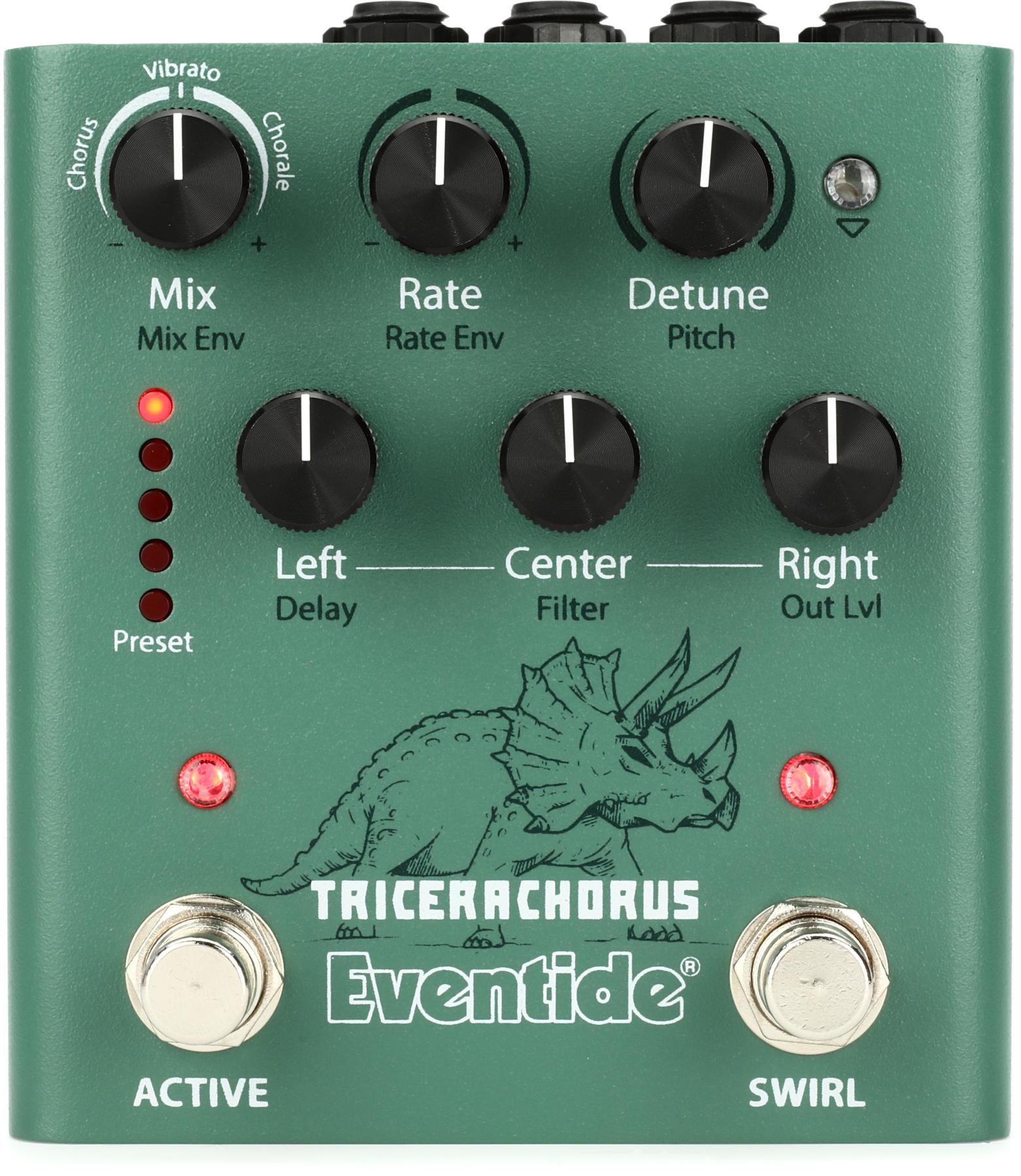
Eventide TriceraChorus Tri-chorus Pedal
Darkglass Anagram Review
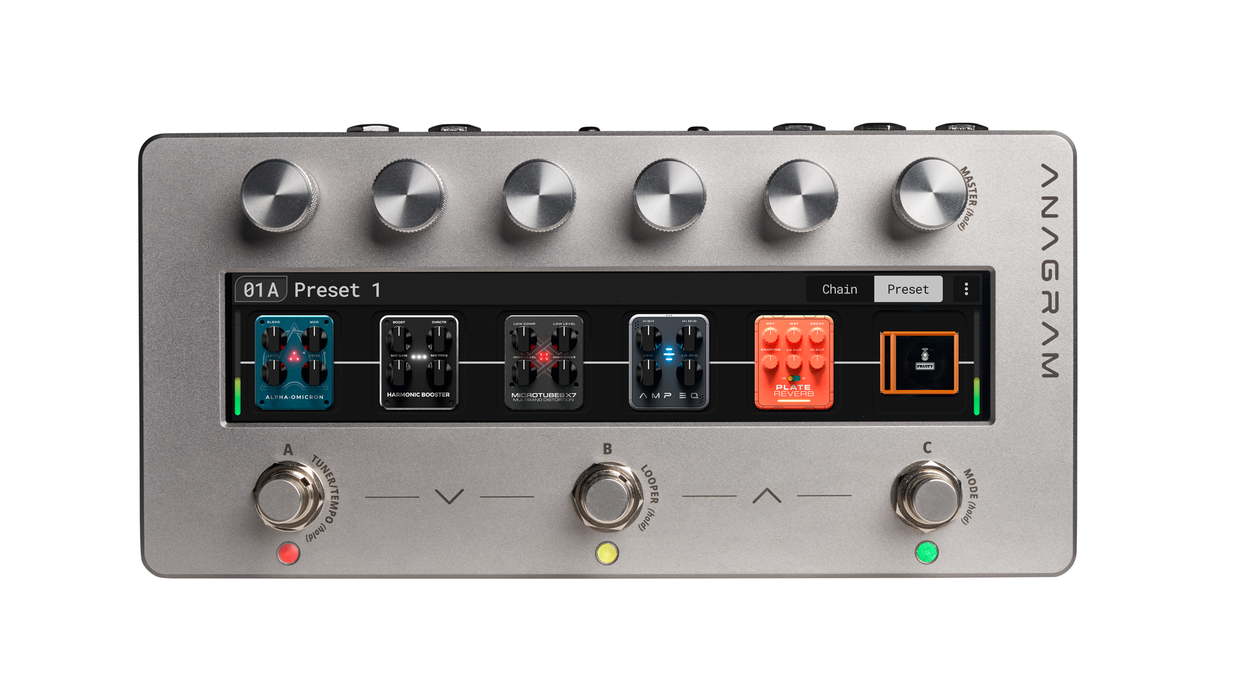
Darkglass Electronics is a bass player’s company. And like many bass-centric brands, they sometimes seem determined to ensure that guitar players aren’t the only ones having fun when it comes to amps and effects. If that’s true, the DSP-driven Anagram may be their most impressive form of revenge yet.
All The Things, All So Small
The Anagram is a sleek unit with just three footswitches and six knobs above the touch screen. Plug in the unit (there’s no on/off) and the screen lights up, welcoming you to your journey. It’s an inviting interface, and it’s hard to avoid the impulse to just start tapping and scrolling.
Connection options are plentiful: There’s a send and return that can be configured as a stereo effects loop or a mono loop and expression pedal input, a 1/8" headphone jack, and a USB-C port along with two 1/8" MIDI ports for connecting an external MIDI controller and sending MIDI. Four outputs take up half of the back panel, with two XLRs and two 1/4" jacks.
Looking Through the Darkglass
There are 19 pages of tutorial you can scan on the touch screen after the initial power up, but that shouldn’t be discouraging. The Anagram is, in general, easy to grasp. There are three modes that can be used to navigate its many features. Preset mode uses footswitches to move between presets, though there will be an audible gap when you switch between them. Stomp mode allows you to use the footswitches to toggle between three virtual stompoxes within a preset, so you can, for instance, use the chorus on a bridge and overdrive for your bass solo. The deeper scene mode enables you to seamlessly switch between scenes, which can include completely different groups of pedals and settings. Think of it as an octopus switching multiple stomps and turning knobs for you all at once.
Three screen views are available: chain, bindings, and name. Chain view provides the most pedalboard-like representation of the signal path. This is where you can manage and route your preset’s effects in an efficient, more “analog” way. It’s intuitive and the most direct way to create a preset from scratch or reshape an existing one. Bindings mode allows access to parameters within a preset and enables you to assign the most critical controls to the six knobs at the top of the Anagram. Name mode displays—you guessed it—the name of the active preset. It’s the easiest readout to see in a low-light stage setting. But if any of the individual views don’t serve your purposes, the modes can be combined in multiple configurations.
The Anagram makes editing global settings a breeze. Hold down the sixth knob to enter mixer mode, where you can control the L/R and XLR outputs—either individually or linked for consistent volume—as well as the headphone and master outputs. Tapping the “EQ” box in this screen takes you to the very precise global EQ, where you can adjust gain, width, and frequency in a range from 25 Hz to 16.0kHz.
Ana-tons of Tone
With more than 50 effects (Darkglass says that thousands of additional effects and amps are available via integration with the Neural Amp Modeler), Anagram's factory presets are a great place to begin exploration. I jumped down the rabbit hole starting with Factory preset 01—“harmonic booster.” In this preset, there are six elements in the chain, and when one of the six knobs along the top row are pressed, the corresponding effect goes dark, signaling that the effect is off. The same six knobs also control user-defined parameters within the effect, or a virtual speaker cab, if you switch one into the chain. Once you’re happy with your tweaks, you tap the three dots on the touch screen and save the preset. It’s really simple. Swapping effects within a preset is just as quick—tap the pedal icon you want to change, and you’ll jump straight to its edit screen.
While the sounds are superb, the Anagram truly shines in its ease of programmability and the precision with which you can switch things up.
Paired with my passive, J-bass-style Bluesman Vintage Eldorado, the harmonic booster preset was enough to make my day. Though there are 12 effect blocks available—or 24 in parallel—in that preset, only five are used in its factory preset form, permitting me to add rich chorus and octave to the already satisfying tone. The depth of familiar effects and amps is impressive. With searing overdrives, signature Darkglass pedals, and a super-wide range of bass-centric effects, I was like a kid in a candy store. And there are also 20 cab options and a boatload of mic options that can be situated in different positions relative to the cab. The options are seemingly endless.
The Verdict
The Anagram is ideal in a lot of settings. For fly dates, it’s compact and easy to re-program if, say, you add a new song to the set on a whim. Provided there is a proper P.A., the unit is truly all you need to get the job done. Able to run the gamut of vintage and modern sounds, it could be a cover-band bass player’s best friend. And while the sounds are superb, the Anagram truly shines in its ease of programmability and the precision with which you can switch things up. From an economic standpoint, the Anagram is the equivalent of purchasing several traditional floor pedals … and then getting hundreds more for free. At just under $1,200, that’s math that makes sense.
It’s All About Feel (Not the Notes)
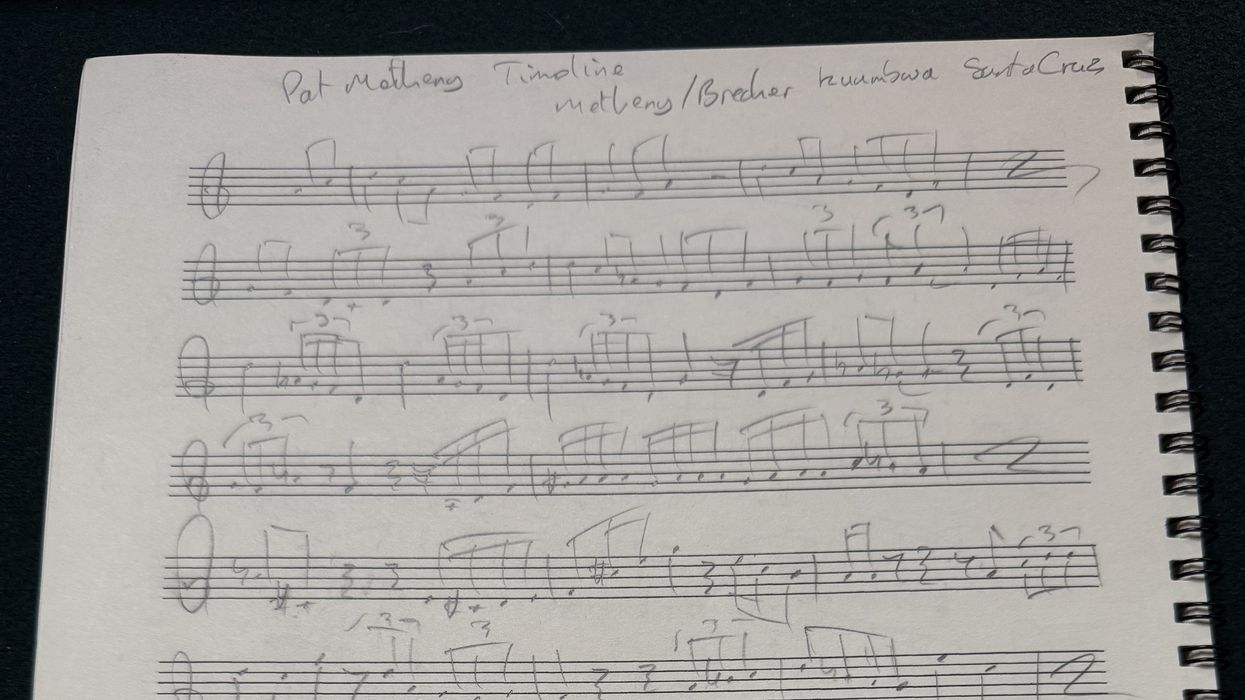
I’m in the middle of writing a book about transcription and ear training. Broadly speaking, I think the two are essentially the same thing.
Transcription, at its core, is about the connection between listening and playing. It’s the real work we do to become more fluent as musicians. Listening, I think, is a relatively low-effort exercise since you can do it almost anywhere, while doing almost anything. On some level, the performance element of our playing could also be considered low-effort when compared to the work required to get there.
There are, of course, exceptions to both—especially in situations like active listening, where you’re learning a piece of intense music in a short space of time, or when you’re on a gig and reading something complicated. Both of those are anything but low-effort. But in general, the real workload comes when we are bridging the gap between them.
Now, whether you refer to it as ear training or transcription, what I’ve come to realize over the three decades I’ve been training my ear and writing things down is that it’s actually all about the feel—and has comparatively little to do with the notes.
Think about being in a room with two people speaking fluent French. You don’t speak a word of it, but there are a few sounds that resemble English. Immediately, you can mimic the sound of their voices, the tempo of their speech, and even approximate an accent. Yes, it’s going to sound terrible at first, and it might come across as if you’re mocking them—trying to speak like them without any actual vocabulary.
But I believe that by mimicking the time, the sound, and the feel of their language, you’ll get closer to fluency much faster once you start adding even the smallest amount of vocabulary. Being able to say hello, goodbye, how are you, and a few other basic phrases with a legitimate-sounding accent and tempo will give the outward impression that you know what you’re doing—and the inward confidence that every new word you learn will feel more authentic than if you had just memorized phrases without ever hearing the language.
I’m a jazz musician, and this method of bridging the gap between listening and playing has been my life’s work. I still practice it almost every day. That doesn’t always mean transcribing pages and pages of John Coltrane solos, but my intent is always guided by curiosity. As soon as I hear something great—or something I don’t immediately understand—I switch into transcription mode and get down to work.
“Singing along to a bass line is priceless. It not only locks the rhythm into your brain, but it also builds instinct for where the root motion of the harmony is going.”
Vocalizing as I listen has always been a fantastic way to get into transcription. It’s not great for anyone listening—I’m a horrific singer—but it’s not about singing all the pitches perfectly in tune. It’s about getting the feel and the rhythmic language of the music embedded in your brain long before you pick up your instrument to learn it, or put pen to paper to write it down. Singing along to a bass line is priceless. It not only locks the rhythm into your brain, but it also builds instinct for where the root motion of the harmony is going. More often than not, the bass is at the bottom of the chord, and being able to pick out the root motion is a superpower when it comes to learning songs or working in a band.
And if, as a result of active listening, vocalizing, and transcription, you build a strong connection between your ear and your instrument, then the feel of the music is always going to be front and center.
Even though everyone in the band should be equally responsible for the time and the feel of a song, we all know that bass players often shoulder more of that weight. We have so much rhythmic and harmonic control from our position in the mix that I think it’s imperative we work even harder on our feel than everyone else. Call me biased, but I think history might back me up on that one.
Stompboxtober 2025: VOX

Stompboxtober continues with today's featured pedal: The VOX Auto Wah V863-CA! Enter below for your chance to WIN all month long.
Stompboxtober 2025 - Win Pedals All Month Long!
VOX Auto Wah V863-CA
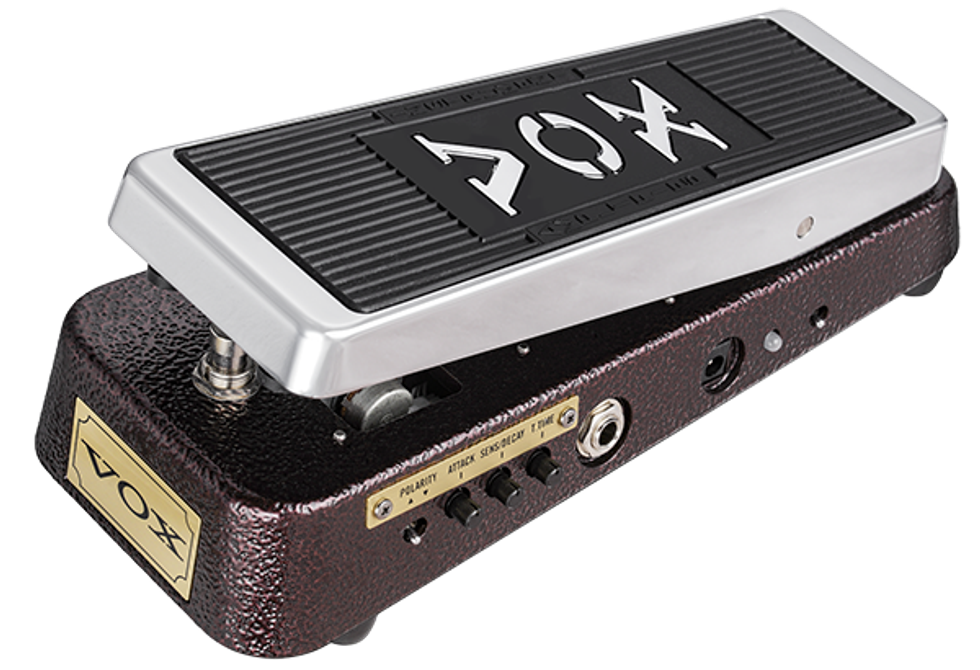
VOX has shaped the sound of expressive guitar since the very first wah. The new VOX Auto Wah marks the next step: combining the classic sweep of a traditional wah with the modern versatility of an auto-wah in one creative, hybrid pedal.
This latest VOX Wah offers three distinct ways to bring your tone alive. In Pedal Mode, it delivers the timeless treadle sweep that defined funk and rock. Envelope Generator Mode introduces automatic movement triggered by your attack, while Envelope Follower Mode responds dynamically to your playing intensity, creating vocal-like textures that shift with every dynamic nuance. Seamless transitions between manual and auto control—simply by stepping on the treadle—keep the pedal feeling intuitive and musical underfoot.
Designed for today’s funk, fusion, jam-band, and experimental players—and inspired by the adventurous spirit of pioneers like Bootsy Collins—the VOX Auto Wah V863-CA blends heritage with innovation. It’s not just a nod to the past; it’s a forward-looking tool for guitarists seeking fresh sounds and new forms of expression.
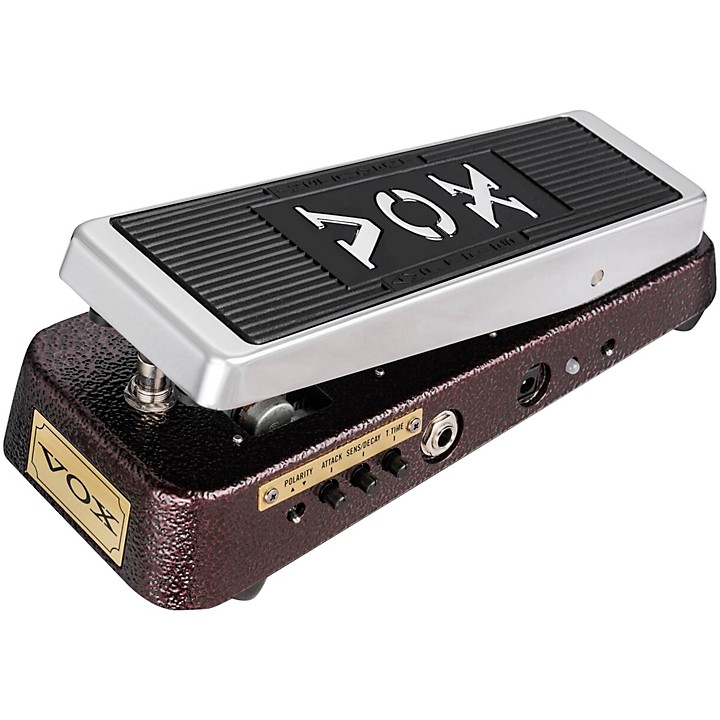
VOX V863-CA Custom Auto Wah Pedal
Fishman AirLock Wireless GT Review
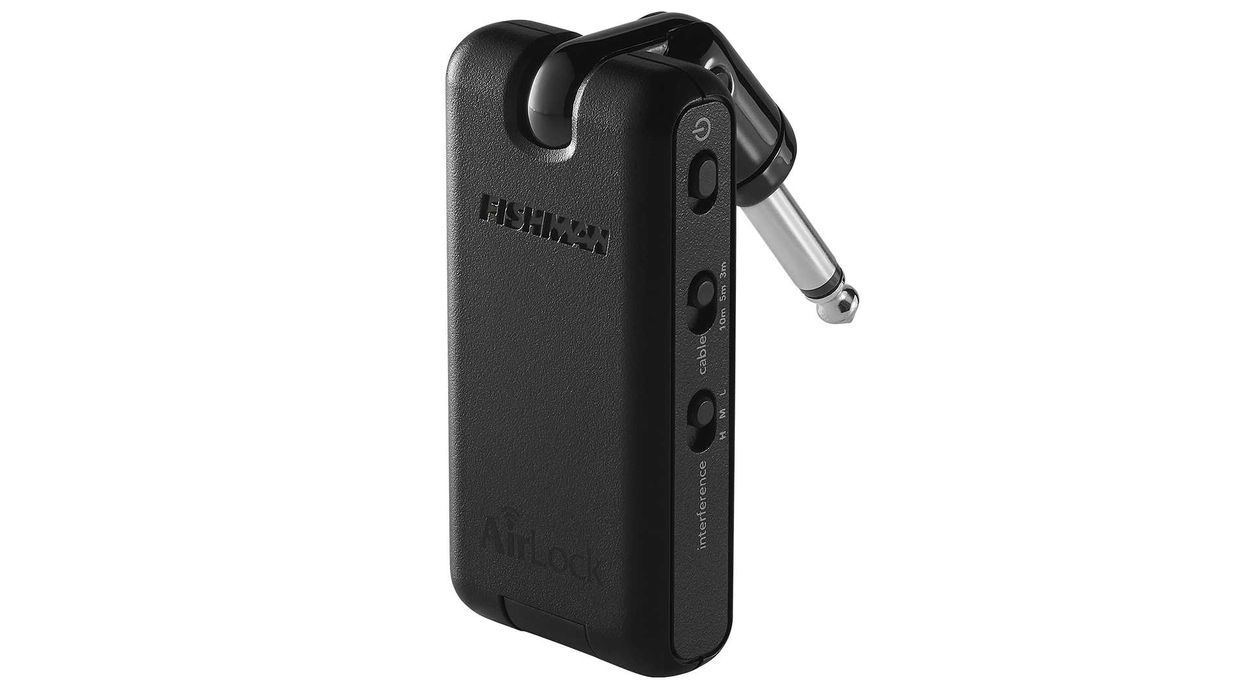
I've kept a keen eye on affordable wireless systems since the late ’90s, when I first decided to go cable-free. The latest entry is Fishman’s look-ma-no-cables debut, the AirLock Wireless GT. It’s an appealing and compact system. There’s a 3.5" x 2.5" receiver that plugs directly into a pedalboard or amp and a 3" x 2" transmitter that plugs into your guitar jack, so size-wise it’s comparable to Line 6’s G30. Like that device, it also has cable tone settings, with positions that replicate the effect the capacitance of 3-meter, 5-meter, and 10-meter cables have on a guitar’s sound.
The kit comes in an 8" x 5" x 3" molded carrying case that includes a Y charging cable to juice up the transmitter and receiver via a single USB out, and a USB data cable. A 5-minute charge gets you two hours of playing time, but a full charge can last for 9 to 10 hours, according to Fishman. There is also a USB power supply that's sold separately, plus the GT can take a barrel pin connector for more permanent pedalboard installs. That’s a lot of options for power.
The transmitter also has a switch to combat frequency interference, with low, medium, and high settings. The higher each setting goes, the higher the latency, but, again according to Fishman, the maximum latency is only 4.9ms, which is, essentially, undiscernible. I certainly could not detect any while I played.
Firing up the AirLock Wireless GT was effortless. The devices are pre-paired and connected instantly every time. The transmitter and receiver also felt very secure when plugged into the inputs of my guitar and my pedalboard, and both devices feature the sam articulating plug, so it’s easy to plug securely into a variety of input-jack styles.
True Tone
Where the AirLock really shines is fidelity, and the cable tone settings are a big part of this device’s overall sonic picture. I loved how sparkling and alive my guitar sounded with the cable tone set at 3 meters: harmonically rich and vibrant in a way my current wireless setup doesn't quite achieve. Honestly, I felt the Wireless GT’s interior circuitry improved my natural tone. With the setting at 5 meters, I heard some loss of high end more like what I’m used to in cost-efficient wireless units. But I also find the resulting darkness and midrange focus appealing, since I typically shoot for a warm, burnished, mid-focused sound. At 10 meters, there was a bit too much detail loss for my tastes, but as always with guitar tones, each individual player’s preferences will out.
The hitch for me was range. While Fishman promises 120 feet under what it refers to as “spin range” conditions (essentially taking a spin around the venue while playing with a lot of energy) and promises that “line-of-sight” is not required, I experienced some dropouts walking just two rooms away from the receiver in my home. When I wandered outside the sound became intermittent at about 50 feet. Granted, there was a wall with a window and a door between me and the receiver, but I’ve gone well over 100 feet off stage in a club and outside into the street, with the signal sustained through a brick wall with glass windows and a door, with my current wireless, which falls in the same price range. Your results may vary.
The Verdict
While my experience with the AirLock Wireless GT’s range didn’t match Fishman’s testimonial, the unit’s price, sound quality, ease of use, and small size is wildly appealing, and I would not hesitate to use it on a large stage or in a space where line of sight is not an issue. As a result, I would urge guitarists looking to play untethered take it for a literal spin themselves.

